


















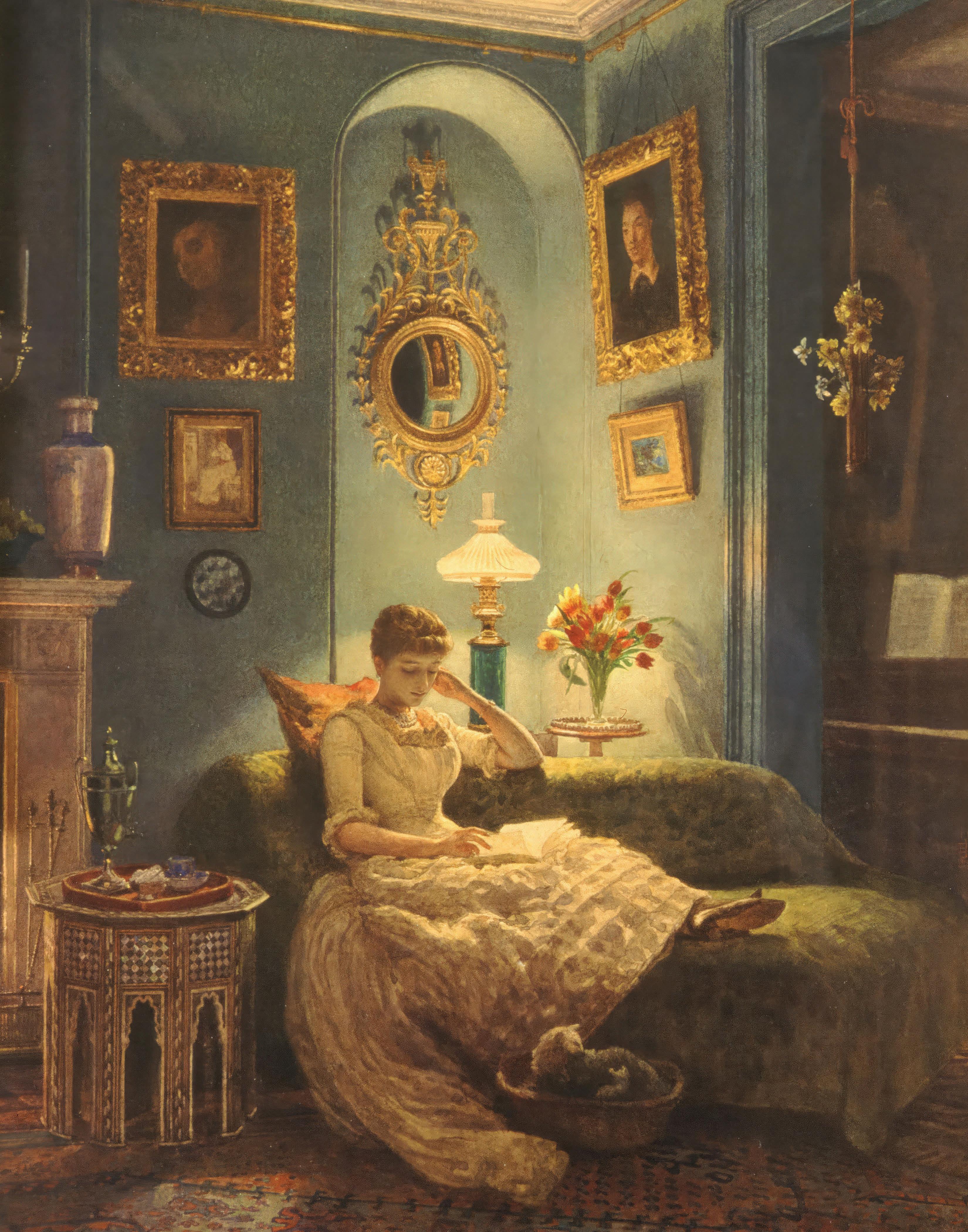





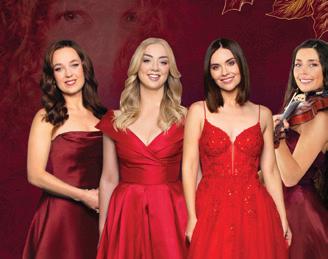


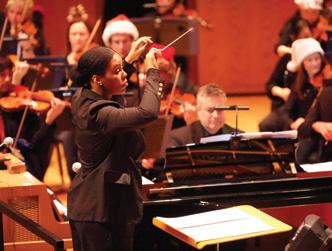

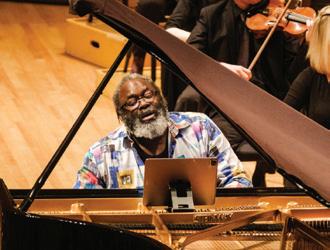




CELEBRATIONS AND TRADITIONS ARE PART OF OUR UTAH HERITAGE. This is a season for both, and whether this is your first time hearing us live or part of a tradition, we are pleased that you have chosen to share this performance with us.
We’re thrilled to share our stages and make music with a host of incredible musicians from around the world this winter season. (Read about some of our musicians’ favorite holiday traditions on pp. 49–50.) From familiar, esteemed conductors like our Music Director Emeritus Thierry Fischer and Assistant Conductor Jessica Rivero Altarriba to our newest colleagues Principal Guest Conductor Delyana Lazarova and Music Director Designate Markus Poschner, along with thrilling guest artists (like Bountiful native Wendy Bryn Harmer, read about her on p. 69), our stages will be filled with unforgettable performers and performances.
As one of only 17 full-time orchestras in the United States, you could call our organization major league. Like elite athletes, our musicians have dedicated their lives to becoming experts at their craft. They compete against hundreds of other extraordinary artists from across the globe to win their position on this musical team, your team, that performs in and lives in your community. But it’s not just our symphony that’s in the big league. Did you know that Utah Opera is one of only six opera companies in the U.S. with the full production capabilities to build an opera from the ground up? It takes an exceptional team of artisans to realize the vision of designers from concept to our stage.
Whether it is the baroque music of Handel’s celebrated Messiah; the classical perfection of Mozart and Beethoven; the rich romanticism of Strauss, Dvořák, Rachmaninoff, and Mahler; the 21st century music of Unsuk Chin, Tania Leon, Mel Tormé, or John Williams; you can hear your Utah Symphony demonstrate their extraordinary versatility and expertise as they deliver moments that will live long in your memory. You can also experience the original multi-media enterprise of opera with a brand-new production of Beethoven’s only opera Fidelio, incorporating modernized dialogue and thought-provoking projections that underscore the power of the human spirit (learn more in a note from director Tara Faircloth on p. 68 and see a preview of costumes created by our in-house costume artisans on pp. 72–74).
Because of the generosity of friends like you, this non-profit organization brings the gift of music year-round to audiences throughout our state and region—with a remarkable one third of that audience comprised of students experiencing one of our many free educational performances. Thank you for being our ambassadors and reminding your friends and family of the gifts we bring to our community.
Sincerely,
Steven Brosvik President & CEO
Annette W. Jarvis Chair, Board of Trustees
p.s. Thinking of holiday gift-giving? Contributions can be made in honor of others and tickets or gift cards for our performances make wonderful gifts for those special people in your life. Share a performance with them and create musical memories together!





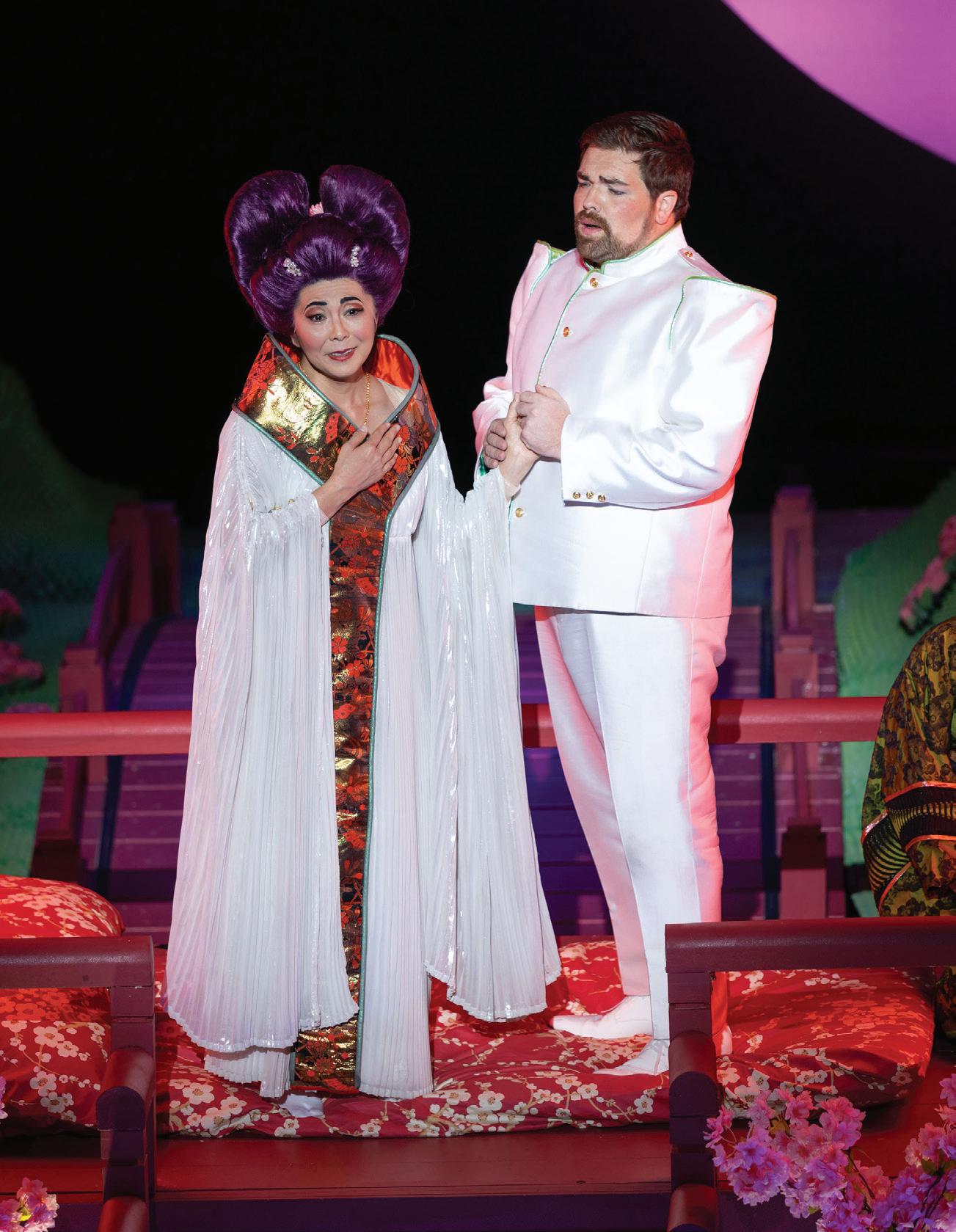

400,000+


Annette W. Jarvis* Chair
Judy Moreton* Vice Chair
Joanne F. Shiebler* Vice Chair
Thomas Wright* Vice Chair
Jason Englund* Secretary
Steven Brosvik*
President & CEO
The O.C. Tanner Chair
Dr. Stewart E. Barlow
Larry Brownstein
Paul E. Burdiss
George Cardon-Bystry
Gary L. Crocker
John D’Arcy*
David L. Dee*
Barry L. Eden*
Senator Luz Escamilla
Jonathan Freedman
Brandon Fugal
Marie Gochnour Gardner
Dennis H. Hranitzky
Stephen Tanner Irish*
Thomas N. Jacobson
Abigail E. Lowder
Derek B. Miller
Dr. Dinesh C. Patel
Frank R. Pignanelli*
Gary B. Porter
Jennifer Price-Wallin
Shari H. Quinney
Miguel R. Rovira
Stan Sorensen
Aaron Starks
Clint Stone
Dr. Shane D. Stowell
Thomas Thatcher
W. James Tozer
David Utrilla
Sharlene Wells
Don Willie
Kim R. Wilson
Henry C. Wurts*
MUSICIAN REPRESENTATIVES
Andrew Keller*
Lissa Stolz*
EX OFFICIO REPRESENTATIVES
Christina Myers Onstage Odgen
Curtis Woodbury Associate Board
LIFETIME BOARD
Kem C. Gardner
Brian Greeff*
Jon Huntsman, Jr.
G. Frank Joklik
Thomas M. Love*
David T. Mortensen
Scott S. Parker
David A. Petersen
Patricia A. Richards* Harris Simmons
HONORARY & TRUSTEES EMERITI
Carolyn Abravanel
Jesselie B. Anderson
Howard S. Clark
Geralyn Dreyfous
Lisa Eccles
Spencer F. Eccles
* Executive Committee Member
Kristen Fletcher
Julie Aiken Hansen
Richard G. Horne
Ronald W. Jibson
Dr. Anthony W. Middleton, Jr.
Edward Moreton
Marilyn H. Neilson
Stanley B. Parrish
Marcia Price
Jeffrey W. Shields, Esq. E. Jeffery Smith
Tickets for Utah Symphony | Utah Opera events can be purchased online at usuo.org, by calling USUO Patron Services at 801-533-NOTE (6683), in person at Abravanel Hall during regular business hours, and through authorized ArtTix sellers.
Discounts may be available for subscribers, students and under-30s, groups of 10 (or more), educators, and military (with valid ID). Contact Patron Services for assistance.
Abravanel Hall Ticket Office
123 W South Temple Salt Lake City, UT 84101 801-533-NOTE (6683) info@usuo.org
• Monday through Friday: 12 PM–6 PM
• CLOSED Saturdays and Sundays without a scheduled performance.
• Saturday with performance: 2 PM–showtime* (by phone and in person)
• Sunday with performance: open 90 minutes prior to showtime* (in-person assistance, only)
*Showtime: The USUO box office will remain open for approximately 30 minutes after the start of each performance for in-person assistance. Phone lines will redirect to voicemail after 6 PM.
Patron Services is available by phone or in person at Abravanel Hall during regular Box Office hours. For hours of operation during weekends, holidays, and special events, please visit us online or contact Patron Services for more information.
Utah Symphony | Utah Opera is committed to making our programming, community engagement, and overall audience experience accessible to people with disabilities. Some features and accommodations include:
• Website Accessibility Interface
• Assisted hearing devices, available by request at Guest Services
• ASL-Interpreted performances
• Closed-captioned or supertitled performances
• Braille or large print programs available by advance request
• Wheelchair, limited mobility, transfer, and bariatric seating available
• Weighted lap pads, earplugs, and other sensory aids available by request at Guest Services
We understand that accessibility needs and standards are shifting daily, so if you see something you would like us to implement or change, please contact our Access Services Administrator, Melissa Robison, at mrobison@usuo.org or 801-869-9067.
Bring a group of 10 or more to any Utah Symphony | Utah Opera performance for special savings and benefits, including:
• Personalized service from a dedicated Group Sales Representative
• Priority seating—groups have access to the best available seats before they go on sale to the general public
• Save up to 20%** off the standard ticket price
• Flexible payment options
• Waived ticket service fees—save up to $3 per ticket
• Recommendations on local attractions and restaurants
**There must be a minimum of 10 persons/students per performance. No discounts are available for Signature performances.
Enjoy exclusive benefits as a season ticket holder with Utah Symphony | Utah Opera!
• Best available seats at the best available price!
• Savings up to 25% off the standard ticket price (and up to 20% on additional purchases)
• Fee-free ticket exchanges
• Waived service fees
• Exclusive access to special presales before they’re available to non-subscribers
• Affordable payment plan options

Utah Symphony | Utah Opera and ArtTix are the only official ticket outlets.
Share your symphony or opera experience—tag us in your photos and memories! @utahsymphony #utahsymphony @utahopera #utahopera
Markus Poschner
Music Director Designate
The Maurice Abravanel Chair, endowed by the George S. and Dolores Doré Eccles Foundation
Thierry Fischer
Music Director Emeritus
David Robertson
Creative Partner
Jessica Rivero Altarriba Assistant Conductor
Austin McWilliams
Chorus Director & Opera Assistant Conductor
VIOLIN*
Madeline Adkins
Concertmaster
The Jon M. & Karen Huntsman Chair, in honor of Wendell J. & Belva B. Ashton
Kathryn Eberle
Associate Concertmaster
The Richard K. & Shirley S. Hemingway Chair
Laura Ha 2nd Associate Concertmaster
Claude Halter Principal Second
Evgenia Zharzhavskaya Acting Associate Principal Second
Karen Wyatt
Acting Assistant Principal Second
Erin David
Emily Day-Shumway~
Joseph Evans
Wen Flatt
Lun Jiang
Rebekah Johnson
Tina Johnson~
Alison Kim
Amanda Kofoed~ Jennifer Kozbial Posadas~
David Langr
Hannah Linz
Yuki MacQueen
Alexander Martin
Rebecca Moench
Suni Norman~
Hugh Palmer
David Porter
Lynn Maxine Rosen#
Elina Rubio
Barbara Ann Scowcroft
Ju Hyung Shin
Bonnie Terry
Julie Wunderle
VIOLA*
Brant Bayless
Principal
The John C. Kish Chair
Yuan Qi
Associate Principal
Julie Edwards
Joel Gibbs
Carl Johansen
Scott Lewis
John Posadas
Leslie Richards~ Whittney Sjogren
CELLO*
Matthew Johnson
Acting Principal
The J. Ryan Selberg Memorial Chair
Andrew Larson
Acting Associate Principal
John Eckstein
Walter Haman
Anne Lee
Louis-Philippe Robillard
Kevin Shumway
Hannah Thomas-Hollands~ Pegsoon Whang
BASS*
David Yavornitzky Principal
Corbin Johnston** Associate Principal
Andrew Keller
Edward Merritt
Masaru Podgorny~
James Stroup~
Jens Tenbroek
Thomas Zera
HARP
Louise Vickerman** Principal
FLUTE
Mercedes Smith Principal
The Val A. Browning Chair
Lisa Byrnes Associate Principal
Caitlyn Valovick Moore
PICCOLO
Caitlyn Valovick Moore
OBOE
Zachary Hammond Principal
The Gerald B. & Barbara F. Stringfellow Chair
James Hall
Associate Principal
Lissa Stolz
ENGLISH HORN
Lissa Stolz
CLARINET
Tad Calcara Principal
The Norman C. & Barbara Lindquist Tanner Chair, in memory of Jean Lindquist Pell
Erin Svoboda-Scott
Associate Principal
The Shane & Stacey Stowell Chair
Lee Livengood
BASS CLARINET
Lee Livengood
E-FLAT CLARINET
Erin Svoboda-Scott
BASSOON
Lori Wike Principal
The Edward & Barbara Moreton Chair
Leon Chodos# Associate Principal
Jennifer Rhodes Acting Associate Principal
Jaquain Sloan~
CONTRABASSOON
Leon Chodos#
Jaquain Sloan~
HORN
Jessica Danz Principal
The Marcia JS Richards Chair
Edmund Rollett** Associate Principal
Lauren Robinson~ Acting Associate Principal
Jonathan Chiou
Julia Pilant~ Stephen Proser
TRUMPET
Travis Peterson** Principal
Alex Mayon~ Acting Principal
Jeff Luke
Associate Principal
Seretta Hart~
Paul Torrisi
TROMBONE
Mark Davidson
Principal
The Nathan & Shannon Savage Chair
In Memory of Neal Savage
Sam Elliot
Associate Principal/Second Trombone
BASS TROMBONE
Graeme Mutchler
TUBA
Alexander Purdy Principal
TIMPANI
Micah Harrow~ Acting Principal
Eric Hopkins
Associate Principal
The Theodore & Elizabeth Schmidt Family Foundation Chair
PERCUSSION
Keith Carrick Principal
Eric Hopkins
Michael Pape
KEYBOARD
Jason Hardink Principal
LIBRARIANS
Clovis Lark Principal
Anna Thompson~ Acting Associate Principal Librarian
ORCHESTRA PERSONNEL
Hannah Thomas-Hollands Orchestra Personnel Manager
String Seating Rotates
On Leave
Sabbatical
Substitute Member
Come tour a campus and see for yourself!

Challenger School offers uniquely fun and academic classes for preschool to eighthgrade students. Our students learn to think for themselves and to value independence.
Farmington (PS–G8) (801) 451-6565
1089 Shepard Creek Parkway
Holladay (PS–K) (801) 278-4797
4555 South 2300 East
Salt Lake (PS–G8) (801) 487-4402
1325 South Main Street
Sandy (PS–G8) (801) 572-6686
10670 South 700 East
Lehi (PS–G8) (801) 407-8777
3920 North Traverse Mountain Boulevard
West Jordan (PS–G1) (801) 565-1058
2247 West 8660 South
UTAH SYMPHONY | UTAH OPERA SEASON SPONSOR
MASTERWORKS SERIES SPONSOR
FAMILY SERIES SPONSOR
UTAH OPERA ARTISTIC DIRECTOR SPONSOR
CONCERT SERIES AT THE NOORDA SPONSOR
POPS SERIES SPONSOR

ASSISTANT CONDUCTOR SPONSOR

CREATIVE PARTNER SPONSOR

OFFICIAL VOICE CARE PROVIDER OF USUO
2025-26 Utah Symphony | Utah Opera Season Sponsor


Enriching excellence in the arts in Utah for more than half a century











1. Almost 500 high school students attended one of our Masterworks concerts in September with their High School Music Clubs.
2. Our Resident Artists demonstrated how simple props and costume pieces help them tell a story in their “Who Wants to Be an Opera Star?” assembly for elementary students.
3. Anja Bihlmaier made a powerful Utah Symphony conducting debut leading Grieg’s Piano Concerto, performed by Orion Weiss.
4. Hagrid surprised young witches and wizards in the Abravanel Hall lobby before Harry Potter and the Chamber of Secrets™ in Concert.
5. Ballet Las Americas de Utah made their Utah Symphony debut in our September Celebración Sinfónica concert wearing folkloric costumes.
6. Utah Opera regular Craig Irvin in The Shining surrounded by two current Resident Artists (Aaron McKone and Rodney Sharp II) and former Resident Artist Christian Sanders.
7. Jeff Luke, our Associate Principal trumpet player, gave Bumble a fist bump at the Bees game in Daybreak this fall before our trumpet section played the National Anthem.
8. Utah Opera Chorus members had a ghostly warmup before a dress rehearsal of The Shining.
ADMINISTRATION
Steven Brosvik
President & CEO
The O.C. Tanner Chair
David Green
Senior Vice President & COO
Micah Luce
Director of Human Resources & Organizational Culture
Julie McBeth
Executive Assistant to the CEO
Natty Taylor
Human Resources Manager
Farrah Valdez
Executive Assistant to the Senior VP & COO
SYMPHONY ARTISTIC
Kerry Smith
Vice President of Artistic Planning
Hannah Thomas-Hollands
Orchestra Personnel Manager
Morgan Moulton
Artistic Planning Manager
Jessica Rivero Altarriba
Assistant Conductor
OPERA ARTISTIC
Christopher McBeth
Opera Artistic Director
Austin McWilliams
Chorus Director & Opera Assistant Conductor
Deborah Robertson
Principal Coach
Michelle Peterson
Director of Production
Ashley Tingey
Production Coordinator
Stephanie Chee, Soprano
Julia Holoman, Mezzo-Soprano
Aaron McKone, Tenor
Rodney Sharp II, Baritone
Jie Fang Goh, Piano
Resident Artists
SYMPHONY OPERATIONS
Jen Shark
Director of Orchestra Operations
Melissa Robison
Front of House Director
Chip Dance
Director of Production
Sarah Madany
Stage Manager
Garrett Vargo
Assistant Stage Manager
OPERA TECHNICAL
Kelly Nickle
Properties Master
Dusty Terrell
Scenic Charge Artist
JR Orr
Head Carpenter/Shop Foreman
Carol Wood
Costume Director
Marcos Ambriz
Cutter/Draper & Costume Manager
Abby Gehring
First Hand
Mallory Goodman
Costume Rentals & Collection Manager
Spencer Smith
Costume Rentals & Collection Assistant Manager
Milivoj Poletan
Master Tailor
Kathryn Wieland
Assistant Tailor
Julie Porter
Crafts Artisan/Milliner
Amy Fernelius
Kelsey Nichols
Lee Sego
Stitchers
Leslie Peterson
Vice President of Development
Garrett Murphy
Director of Development
David Hodges
Director of Development, Institutional Giving
Calli Forsyth
Assistant Director of Institutional Sponsorships and Engagement
Katie Swainston
Assistant Director of Individual Giving
Lisa Poppleton
Grants Manager
Dallin Mills
Development Database Manager
Ellesse Hargreaves
VIP & Sponsorship Benefits Manager
Lindsey Perlman
Donor Engagement Manager
MARKETING & COMMUNICATIONS
Meredith Kimball Laing
Vice President of Marketing &
Communications
Julia Lyon
Communications Manager
Emma Price
Marketing Manager
Nina Starling
Website Content Coordinator
Camila Baltazar
Marketing & Communications Coordinator
PATRON SERVICES
Faith Myers
Director of Patron Engagement
Jaron Hatch
Patron Services Manager
Caitlin Marshall
Sales & Engagement Manager
Toby Simmons
Patron Services Assistant Manager
Genevieve Gannon
Group Sales Associate
True Moore
Chloe Toyn
Patron Services Specialists
Michael Gibson
Ananda Spike
Val Tholen
Samantha Morris
Kjelbi Elassali
Tanush Saran
Patron Services Associates
ACCOUNTING & INFORMATION TECHNOLOGY
Jeffrey Andreasen
CFO
Mike Lund
Director of Information Technologies
Melanie Giles Controller
Jared Mollenkopf
Patron Information Systems Manager
Bobby Alger
Accounts Payable Specialist
Ben Kipp
Vice President of Education & Community Engagement
Kevin Nakatani
Opera Education Manager
Beth Foley
Education Coordinator
We would also like to recognize our volunteers, interns, and temporary and contracted staff for their work and dedication to the success of Utah Symphony | Utah Opera.

DISCOVER THE ADVENTURE-READY, CITY-SAVVY 2025 BMW X3.
When you pair “adventure ready” with “city savvy,” you’ll find a vehicle that lives at the intersection of downtown avenues and mountain roads: the BMW X3.
With a reimagined design and sporty handling, the latest iteration of this icon doesn’t just tackle any journey with ease; it draws attention while doing it.
And it wouldn’t earn the X3 name without versatility at its heart and a premium interior that makes it unmistakably BMW.
Visit BMW of Murray or BMW of Pleasant Grove for exceptional offers on the BMW X3.
BMW of Murray
4735 S. State Street
Murray, Utah
801-262-2479
bmwofmurray.com
BMW of Pleasant Grove 2111 West Grove Parkway Pleasant Grove, Utah 801-443-2000
bmwofpg.com


FRIDAY, NOVEMBER 21, 2025 / 7:30 PM / MAURICE ABRAVANEL HALL
SATURDAY, NOVEMBER 22, 2025 / 7:30 PM / MAURICE ABRAVANEL HALL
JESSICA RIVERO ALTARRIBA, conductor
SHAYNA STEELE, vocalist
CHESTER GREGORY, vocalist
MICHAEL LYNCHE, vocalist
UTAH SYMPHONY
SMOKEY ROBINSON
JAMES BROWN, BETTY JEAN NEWSOME, & DWIGHT GRANT
HOLLAND, DOZIER, & HOLLAND
MICHAEL MASSER & RONALD NORMAN MILLER
JIMMY GEORGE & LOUIS PARDINI
HOLLAND, DOZIER, & HOLLAND
NICK ASHFORD & VALERIE SIMPSON
LEON RUSSELL
STEVIE WONDER
“Dancing in the Street”
“You Really Got A Hold On Me”
“Man’s World”
“Reach Out I’ll Be There”
“Touch Me In The Morning”
“Just To See Her”
“How Sweet It Is”
“Ain’t No Mountain High Enough”
“Song For You”
“Superstition”
INTERMISSION
MAURICE WHITE & WAYNE LEE VAUGHN
JAMES BROWN
SMOKEY ROBINSON
SMOKEY ROBINSON & RONALD WHITE
LIONEL RICHIE
MELVIN STEALS & MERVIN STEALS
KENNETH GAMBLE, LEON HUFF, & CARY GILBERT
GARY JACKSON, RAYNARD MINER, & CARL WILLIAM SMITH
LIONEL RICHIE
STEVIE WONDER, LEE GARRETT, LULA MAE HARDWAY, & SYREETA WRIGHT
“Let’s Groove Tonight”
“I Feel Good”
“My Guy”
“My Girl”
“Endless Love”
“Could It Be I’m Falling In Love”
“Don’t Leave Me This Way”
“Higher and Higher”
“All Night Long”
“Signed Sealed Delivered”

CONDUCTOR SPONSOR


NUANCED INTERPRETATIONS, dynamic energy, and a charismatic stage presence are hallmarks of Cuban conductor Jessica Altarriba. Praised for her communicative skills, impactful performances, and equally vested in both established and wellknown repertoire as well as contemporary compositions, Altarriba currently serves as Assistant Conductor for the Utah Symphony and is a Taki Alsop Fellowship Award Recipient (2024–26). Altarriba is concurrently pursuing her master’s degree in conducting at the Peabody Institute of Johns Hopkins University.
This past summer, she conducted the Utah Symphony’s summer community concerts as well as select concerts at the Deer Valley Music Festival, including Tchaikovsky’s 1812 Overture, closing the festival. She also participated in the Youth Orchestra Los Angeles National Festival in California, collaborating with LA Philharmonic Artistic Director Gustavo Dudamel, YOLA Artistic Director Gaudy Sanchez, and the YOLA National Team in festival programming and conducting a final concert in collaboration with Dudamel.
THROUGHOUT HER CAREER, Shayna Steele has lent her talent to leading artists such as Grammy-winning trumpeter Chris Botti and electronic music producer Moby, whose tracks “Raining Again,” “Disco Lies,” and “Extreme Ways” featured Steele’s blockbuster vocals. The band Snarky Puppy’s Michael League handpicked Steele’s original track, “Gone Under,” for inclusion in their hit album Family Dinner, Volume 1 (Ropeadope Records), which has become a viral sensation with more than 2 million views and countless covers from musicians globally. No stranger to both the small and silver screens, Steele has sung on the soundtracks of Hairspray, The Bourne Identity, and Sex and the City 2, as well as making a guest appearance on The Sopranos. Steele recently made an appearance in two episodes of the DC series The Penguin, starring Colin Farrell, on MAX.
Steele holds a music degree from the prestigious Berklee School of Music in Interdisciplinary Music Studies and teaches private vocalists virtually. Steele has also been a guest for many college masterclasses and workshops globally.

CHESTER GREGORY is an award-winning Broadway actor, singer, and recording artist, renowned for his extraordinary vocal talent, commanding stage presence, and deep emotional resonance. With starring roles in iconic productions such as Hairspray, Dreamgirls, Sister Act, Disney’s Tarzan, and Motown: The Musical, Gregory has become a dynamic force in musical theater and live performances, captivating audiences with a unique energy that resonates across both grand Broadway stages and intimate concert settings.
A recipient of the NAACP Theatre Award, Joseph Jefferson Award, and Black Theatre Alliance Award, Gregory has performed across the U.S., gaining recognition not only for his vocal abilities but also for his emotional depth and stage presence. His influence extends beyond live performances through his social media, where he engages millions, sharing his artistic journey, humor, and passion for wellness.

AMERICAN IDOL finalist Michael Lynche is a new breed of soul singer with completely classic influences. Traces of Donny Hathaway, Al Green, Luther Vandross, Sam Cooke, and James Brown all seem to flash in this uniquely talented performer. Undeniable charisma, well-crafted song arrangements, and a voice soaked in soul give the big man a class all his own. “Big Mike”—as he was known while winning over the hearts of a nation during his stint on American Idol—has talent so versatile that he’s played intimate jazz and blues clubs, 20,000-seat arenas, and opera halls with 100-piece orchestras backing him. Through it all, “Big Mike” has always had one goal: to spread a message of love wherever he goes.
His show credits include R&B Legends, Kings of Soul, Dancing in the Street: The Music of Motown, and Holiday Pops: Soulful Christmas


SATURDAY, NOVEMBER 29, 2025 / 7:30 PM / MAURICE ABRAVANEL HALL
SUNDAY, NOVEMBER 30, 2025 / 7:30 PM / MAURICE ABRAVANEL HALL
JESSICA RIVERO ALTARRIBA, conductor
STEPHANIE CHEE, soprano
JULIA HOLOMAN, mezzo-soprano
AARON MCKONE, tenor
RODNEY SHARP II, baritone
UTAH SYMPHONY CHORUS
AUSTIN MCWILLIAMS, chorus director
UTAH SYMPHONY

CONDUCTOR SPONSOR

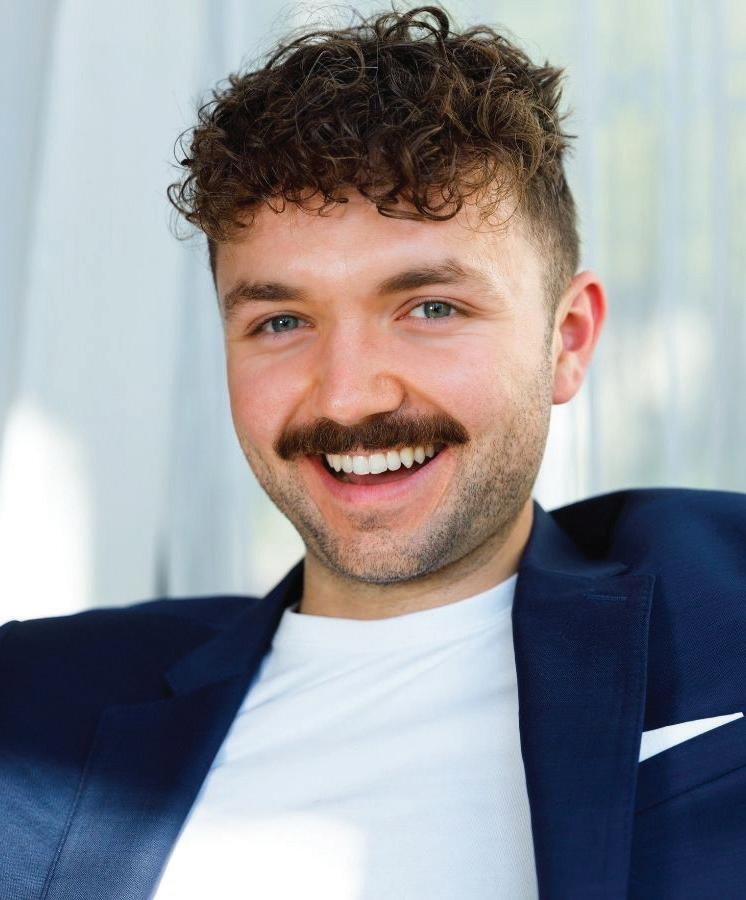


AUSTIN MCWILLIAMS is a conductor and countertenor who specializes in contemporary vocal music. He strives to present compelling, intriguing art that is directly relevant to the communities in which it is performed. This season marks his second as Chorus Director & Opera Assistant Conductor at Utah Symphony | Utah Opera.
Previously, McWilliams was Associate Conductor and Chorus Master at Opera Grand Rapids, Head of Music at West Michigan Opera Project, and Co-Artistic Director at Ad Astra Music Festival. In Grand Rapids, he was the choir director at Fountain Street Church, a non-denominational, non-creedal institution that serves as a venue for heterodox speakers and ideologies.
A dedicated conductor and educator, McWilliams has served as Director of Choral Activities at Aquinas College and as adjunct faculty at Western Michigan University. He is also a faculty member at Missouri Scholars Academy, a governor’s school for gifted high school juniors in his native state.
ORIGINALLY FROM SUNNYVALE, CALIFORNIA, soprano Stephanie Chee returns to Utah Opera as a Resident Artist for the 2025–26 season, performing Mrs. Grady in The Shining, Marzelline in Fidelio, Gianetta in The Elixir of Love, and Annina in La traviata. She last appeared with Utah Opera as Dew Fairy in Hansel and Gretel. An accomplished musician, Chee was a winner in the Utah District of the 2024 Metropolitan Opera Laffont Competition. She was also awarded an Emerging Talent Award in the 2023 Lotte Lenya Competition, first place in the 2022 Fox Valley Collegiate Voice Competition, second place in the 2022 Upper College Treble Voices Division of the National Student Auditions, and the Farwell Trust Award in the 2022 Musicians Club of Women Voice Competition. Chee received her master’s degree from Rice University in 2024.
JULIA HOLOMAN is a mezzo-soprano from Raleigh, North Carolina, and a recent graduate of the master’s program at the Shepherd School of Music at Rice University. Over the past year, Holoma has performed the role Ruggiero in Handel’s Alcina and was named a semi-finalist in Houston Grand Opera’s Concert of Arias. Other recent roles include The Sorceress and Dido in Purcell’s Dido and Aeneas. This past summer, Holoman was a Lehrer Artist at Music Academy of the West where she sang the alto solo in Mahler’s Symphony No. 3 with the Academy Festival Orchestra under the baton of Miguel Harth-Bedoya. She performed the role of Mrs. Massey in Paul Moravec and Mark Campbell’s The Shining and is greatly looking forward to performing the role of Flora in Verdi’s La traviata this season with Utah Opera.
This perfomance is her Utah Symphony debut.


AARON MCKONE, deemed a “rising star” and praised for his “ardent tenor,” is very excited to return to Utah Opera for the 2025–26 season during which he will perform the roles of Lloyd/Watson (The Shining), Jaquino (Fidelio), and Gastone (La traviata). In past seasons, McKone was an Apprentice Artist with Santa Fe Opera, Studio Artist at Wolf Trap Opera, Resident Artist with Opera Naples in Florida, and Vocal Fellow at the Spoleto Festival USA. He also performed with the Cincinnati Symphony Orchestra in collaboration with Paris’ Opéra Comique and was a featured soloist with the National Orchestral Institute and Festival. Some notable roles McKone has sung are Faust (Faust), Rinnuccio (Gianni Schicchi), and Eisenstein (Die Fledermaus). McKone received his bachelor’s degree from Winthrop University as well as a master’s degree and Artist Diploma from the University of Cincinnati College-Conservatory of Music, where he studied with Tom Baresel and Stuart Skelton.
RODNEY SHARP II is a proud native of Fort Worth, Texas, and holds a bachelor’s degree in music, voice performance from Prairie View A&M University and a master’s degree in opera performance from Arizona State University. Some of Sharp’s favorite roles performed are Peter (Hansel and Gretel), Gianni Schicchi (Gianni Schicchi), and Nick Shadow (The Rake’s Progress). He has performed as a soloist in Mozart’s Requiem, Kodály’s Missa Brevis, and Schubert’s Mass in G. Praised for his “…deep and robust voice combining strong vocalism and magnetic presence, he is a natural scene stealer.” Sharp is an advocate for classical music by African American composers and strives to present works representing the African American experience. As a second-year Resident Artist at Utah Opera, Sharp will perform the roles of Horace Derwent (The Shining), Don Fernando (Fidelio), and Marquis d’Obigny (La traviata), in addition to performing in schools and communities throughout the state of Utah beside his fellow Resident Artists to spread the good word of opera.

Soprano
Joanna Armstrong
Cydnee Barnum Farmer
Caitlyn Bramble
Christina Brandt
Anadine Burrell
Jana Conrad
A. Elizabeth Davis
Julie Fleming
Kaylynne Fox
Emelia Hartford
Elliott Jeppsen*
Alexandra Montoya
Kate Olsen
Michelle Reid Quinn
Anna Roelofs
Anna Sangrey Roussel
Natalie Sandberg
Hannah VonHatten
Jennifer Way Zemp
Breanne White
Alto
Caite Beck
Joan Jensen Bowles
Sylvia Fisk
Kate Fitzgerald
Gabriella Gonzales
Erika Gray
Jennifer Hancock
THE UTAH SYMPHONY CHORUS is composed of volunteer singers from the Salt Lake City area who come from all walks of life. The chorus typically performs three concerts each season with the Utah Symphony in Abravanel Hall, which may include choral masterworks, pops concerts, and the annual Messiah Sing-In. Singers have performed under the baton of Utah Symphony Music Directors Maurice Abravanel, Varujan Kojian, Joseph Silverstein, Keith Lockhart, and Thierry Fischer, as well as numerous guest conductors including Robert Shaw, Margaret Hillis, Roger Wagner, Peter Eros, Bernard Labadie, Andrew Litton, Stanisław Skrowaczewski, and many others.
The Utah Symphony Chorus rehearses Tuesday evenings for several weeks before each concert and most evenings the week of a performance. Visit usuo.org/Choruses to learn more about joining the chorus.
Annette W. Jarvis
Catherine Jeppsen
Raenell Jones
Samantha Lange
Ruth Rogers
Isabella R. Sausedo*
Jenica Sedgwick
Sue Sohm
Michelle Swenson
Jennifer Taylor
Maizie Toland
Sammie Tollestrup
Dawn Veree
Kathy Wight
Ruth Wortley
Tenor
Stephen Anderson
Drake Bennion
Mosiah Cipriani
Holden Deitsch
Elijah Hancock
Samuel Hancock
Tim Hanna
Nate Kemp
Isaac Lee
Jeanne Leigh-Goldstein
John Pearce
Joshua Peterson*
Alan Robertson
Kevin Rowe
Ben Schneider
Jesse Skeen
John P. Snow
Scott Tarbet
Carl Wadsworth
John Woeste
Edgar Zuniga
Bass
Aaron Asay
Olivier Bauer Simon
Bruce Boyes
Colton Butler
Richard Butler
Carson Hancock
Michael Hurst
Camden Lawrence
Lyman Moulton
Michael Moyes
Vincent Nguyen
Richard Olsen
Chris Patch
Gabriel Poulson
Nathan Scott
Marc Titcomb
Matthew Toone
*The Cathedral of the Madeleine High School
Choir Member



TUESDAY, DECEMBER 2, 2025 / 7:00 PM / MAURICE ABRAVANEL HALL
LLOYD BUTLER, conductor
CELTIC WOMAN, vocals and violin
UTAH SYMPHONY
SELECTIONS TO BE ANNOUNCED FROM THE STAGE.

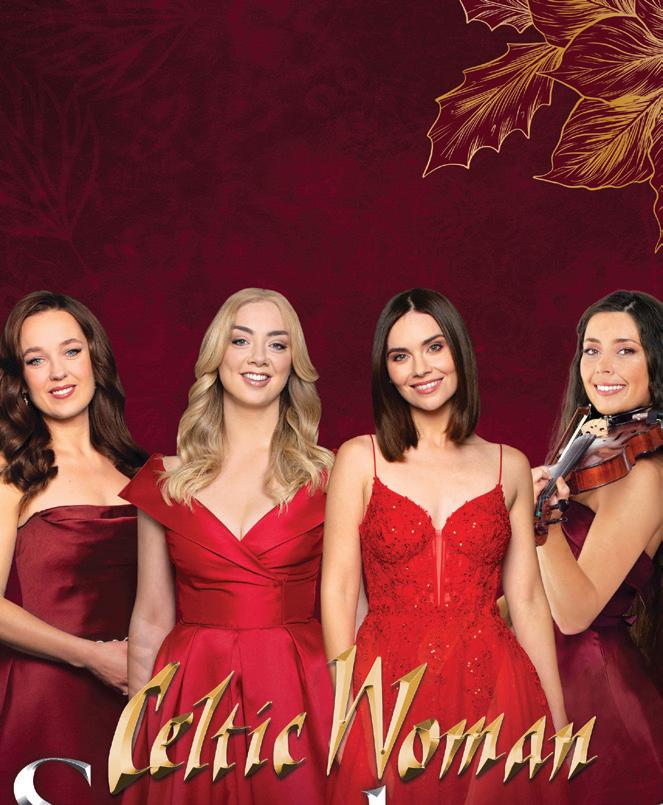
IN THE STILLNESS OF WINTER, as the world quiets, familiar melodies drift like snowflakes: gentle, timeless, and full of wonder. Celtic Woman’s Symphony Tour is a reflection of that magic. It moves between light and shadow, tradition and newness, capturing the spirit of Christmas in its most delicate form. Each song is a window into a winter’s evening, some familiar, some reimagined, all wrapped in a feeling of joy. Celebrate the holiday season with the celestial voices of Grammy-nominated multi-platinum Irish singing sensation Celtic Woman. This is a wonderful opportunity to hear Celtic Woman’s angelic harmonies with the thrilling live sound of a full symphony orchestra in an intimate concert setting. Join sopranos Mairéad Carlin & Muirgen O’Mahony and two brand-new Celtic women: Sean-Nós singer Caitríona Sherlock and fiddle player, Ciara Ní Mhurchú for a show featuring all of your favourite Yuletide songs: “O Holy Night,” “Little Drummer Boy,” “Silver Bells,” “Have Yourself a Merry Little Christmas” & more, along with Celtic Woman classics and some Irish tunes with a Christmas twist. So, take your seat, and prepare for the new era of Celtic Woman with an enchanting evening filled with holiday cheer. Celtic Woman is the most successful all-female group in Irish history, with a legacy of 12 Billboard number ones, over 10 million album sales, and over 3 billion online streams to date.





TO THE COMFORTS OF HOME THIS HOLIDAY

FRIDAY, DECEMBER 5, 2025 / 7:30 PM / MAURICE ABRAVANEL HALL
SATURDAY, DECEMBER 6, 2025 / 5:30 PM / MAURICE ABRAVANEL HALL
MARKUS POSCHNER, conductor
VADIM GLUZMAN, violin
UTAH SYMPHONY
SHOSTAKOVICH
Violin Concerto No.1 in A minor, Op. 99 (34’)
I. Nocturne
II. Scherzo
III. Passacaglia
IV. Burlesca
INTERMISSION
R. STRAUSS
Ein Heldenleben (A Hero’s Life), Op. 40 (46’)
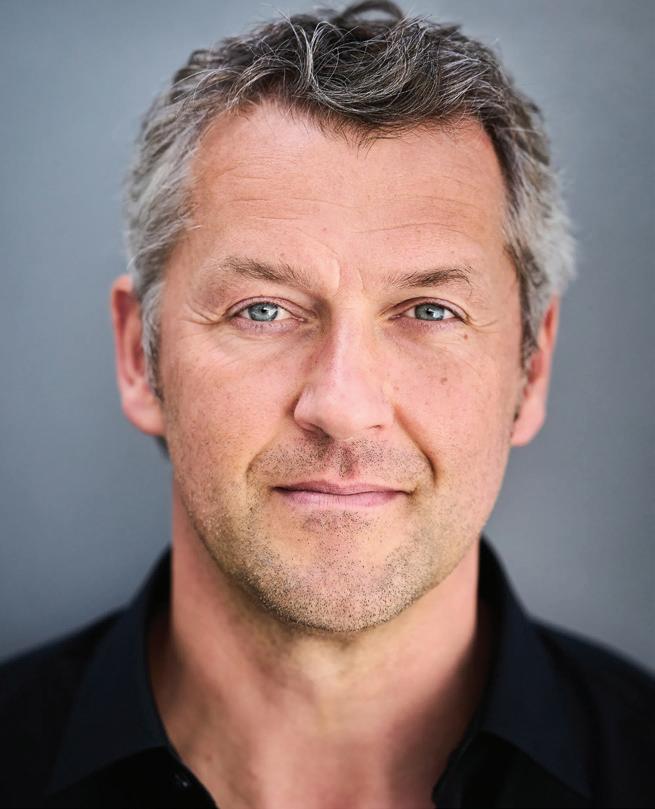
MARKUS POSCHNER is Music Director Designate of the Utah Symphony, assuming full duties as Music Director beginning in the 2027–28 season. This season, Poschner begins his tenure as Chief Conductor of Sinfonieorchester Basel and, in 2026–27, he becomes Chief Conductor of the ORF Vienna Radio Symphony Orchestra.
He was Chief Conductor of the Orchestra della Svizzera Italiana from 2015 to 2025, leading the orchestra in two International Classical Music Award-winning recordings: the complete Brahms symphonies in 2018 and a Hindemith/ Schnittke recording in 2025. His recording of Offenbach’s Maître Péronilla with the Orchestre National de France was honored with the German Record Critics’ Award 2021. In 2024, Poschner received the Special Achievement Award from the ICMA jury for the complete recording of all Bruckner symphonies with the Bruckner Orchestra Linz, of which he has been Chief Conductor since 2017, and the ORF Vienna Radio Symphony Orchestra. Together with Bruckner Orchestra Linz, he was given the Orchestra of the Year and Conductor of the Year prizes at the Austrian Music Theatre Awards 2020.

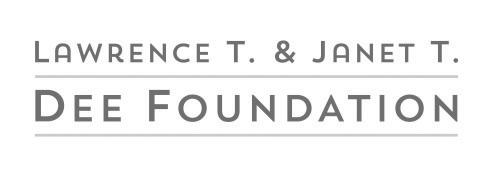
UNIVERSALLY RECOGNIZED among today’s top performing artists, Israeli violinist Vadim Gluzman is acclaimed for his appearances with the Berlin Philharmonic, Boston Symphony Orchestra, London Symphony Orchestra, and Royal Concertgebouw Orchestra under Riccardo Chailly, Christoph von Dohnányi, Tugan Sokhiev, Santtu-Matias Rouvali, and other leading conductors.
Gluzman has introduced audiences to new works by Sofia Gubaidulina, ErkkiSven Tüür, Pēteris Vasks, Giya Kancheli, Moritz Eggert, Elena Firsova, and Lera Auerbach, and currently serves as Artistic Director of both the Music in the Mountains and North Shore Chamber Music Festivals.
Accolades for Gluzman’s striking catalogue of recordings on the BIS, Platoon, and EuroArts labels include the Diapason d’Or of the Year, Gramophone’s Editor’s Choice, Classica magazine’s Choc de Classica award, and Disc of the Month by The Strad, BBC Music Magazine, and Classic FM.
Distinguished Artist in Residence at The Peabody Conservatory, where he teaches a selected group of young violinists, Gluzman performs on the extraordinary 1690 “ex-Leopold Auer” Stradivari, on loan through the Stradivari Society of Chicago.
BY NOEL MORRIS
Richard Strauss wrote his hero’s tale, “A Hero’s Life” (Ein Heldenleben), alongside his tragicomedy Don Quixote and even recommended they be performed together.
Dmitri Shostakovich wrote his first violin concerto for David Oistrakh, who remained a consummate musician and loyal friend. In appreciation, the composer presented him with a second violin concerto (1967) for his 60th birthday.
Richard Strauss was a superstar several times over: as a conductor, as a composer of tone poems, as a songwriter, and, after 1900, as an opera composer.
Shostakovich based the third movement of the Violin Concerto No. 1 on a Baroque form called the passacaglia. Here, the composer makes a daisy chain of a repeated 17-bar tune heard first in the baseline. A gigantic cadenza at the end of the movement puts the soloist through an endurance test. The story goes that, originally, the soloist was to launch the finale, but violinist David Oistrakh asked the composer for a break to wipe the sweat from his face. Shostakovich laughed and good-naturedly rescored the finale’s opening bars.

born September 25,1906 in St. Petersburg, Russia died August 9, 1975 in Moscow
composed 1947–1948 premiered in Leningrad on October 25, 1955
During the 1930s, Joseph Stalin rounded up millions of his own people—teachers, scientists, Communist Party officials, clergy, farmers, Red Army officers, and cultural figures. Stalin murdered many and sent others to gulags. Everyone was touched, but they learned not to grieve in public. It wasn’t safe.
Dmitri Shostakovich lost friends and family but personally got off with a warning. It started with his wildly popular
opera Lady Macbeth of the Mtsensk District. Stalin walked out mid-performance. A scathing review followed. And overnight, the composer’s income vanished, and friends started crossing the street to avoid him. He recovered in 1937 with his dazzling Fifth Symphony.
During World War II, Stalin was too busy fighting Hitler to persecute artists, and so Shostakovich took risks. His terrifying Seventh Symphony depicts mindless militarism, which he directed at Hitler. The Eighth is funereal (he described it as “bright and gay”). For the Ninth, written in 1945, he’d promised an epic victory symphony—it’s actually short and slapsticky. In his way, Shostakovich danced the line between compliance and defiance.
In the summer of 1947, Shostakovich started work on his Violin Concerto No. 1. Already, Communist Party officials had been cracking down on literary figures. In 1948, they trained their wrath on composers. They dismissed Shostakovich from his conservatory jobs, burned his Eighth and Ninth Symphonies, and forced him to apologize for writing them. When he finished his Violin Concerto, he showed it to the violin virtuoso David Oistrakh, but stuck the piece “in the drawer”—Shostakovich’s phrase for works he considered too risky to make public.
The Violin Concerto No. 1 is unconventional, as far as concertos go. It has four movements, like a symphony, and opens with a nocturne. Eschewing the typical soloistic show-off piece, the Nocturne conveys restrained sorrow, as if someone were weeping into a pillow at night.
Keeping with the symphonic vibe, Shostakovich wrote a scherzo for the second movement, complete with a sassy Klezmer-like theme (likely, a response to Soviet persecution of Jews in 1948).
The scherzo introduces the Shostakovich monogram, in which he used the German spelling of his name, D. Schostakovich, to build a musical cipher. (Because E-flat and B-natural are called S and H in German, the notes D-Eb-C-B spell D-S-C-H.)
In the flamboyant finale, Shostakovich returns to the bittersweet sound of Klezmer—not a popular—or safe— reference in 1940s Soviet circles.
The Violin Concerto No. 1 remained in the drawer until after Stalin’s death in 1953. David Oistrakh played the premiere in 1955. Two months later, he played it at Carnegie Hall.

RICHARD STRAUSS
born June 11, 1864 in Munich, Bavaria died September 8, 1949 in Garmisch-Partenkirchen, Germany
composed 1897–1898 premiered in Frankfurt, Germany on March 3, 1899
The Backstory
Ein Heldenleben means “a hero’s life,” which plays into our loose conception of a hero, from firefighters to ball players to rock stars.
19th-century creatives liked the idea of an artist as a hero, someone gifted with intuition, who gains access to higher truths and shares them with the world. At first, the artist feels lonely and misunderstood. But the fire in the belly grows ever stronger until the artist risks everything— financial security, rejection, disapproval, and social isolation to glean those higher truths.
History and literature offer famous examples of hero-artists, from Goethe’s Young Werther to Beethoven, who overcame deafness to write the Ninth Symphony It’s the essence of Romanticism—individualism, personal struggle, and the triumph of the human spirit.
Richard Strauss contributed to the genre with Ein Heldenleben, complete with epic battles, true love, and public affirmation. When Strauss conducted the first performance, most everyone figured out his hero’s identity: himself (Ein Heldenleben has a mélange of snippets from his other works).
“He was not conceited,” insisted a family friend, “but he
knew his force—that he was a somebody.”
Indeed, he was. Richard Strauss enjoyed a long run as (arguably) the world’s then most popular musician and composer. He was a wunderkind conductor, landing a job at the Munich Court Opera at 22. He added rocket fuel to his career with the tone poem Don Juan at 23, then scored one hit after another (pun intended).
Strauss believed the tone poem would replace the symphony as the go-to standard orchestral composition. Of course, this notion played into his uncanny ability to describe things using musical instruments. As he wrote Ein Heldenleben, he added verbal cues as if scoring a movie, writing things like, “he bestirs himself and looks and sinks back into G-flat.”
Since then, fans have made a sport of sleuthing all the Strauss tunes embedded in the piece, from Don Juan to Don Quixote. The dramatic arc follows the composer, his wife named Pauline, their love making, and the abuse levied by carping critics played by squawking woodwinds.
Strauss wrote Ein Heldenleben for Willem Mengelberg and The Concertgebouw, where they carved his name into the Great Hall in giant gold letters. To this day, people snort at Strauss’ act of immodesty. On the other hand, he lived to witness the manifestation of heroism gone awry during the world wars.
“Our future lies in art, especially in music,” he said. “In times when spiritual goods are rarer than material ones, and egoism, envy, and hatred govern the world, music will do much to re-establish love among mankind.”
Perhaps we all need heroes like that.

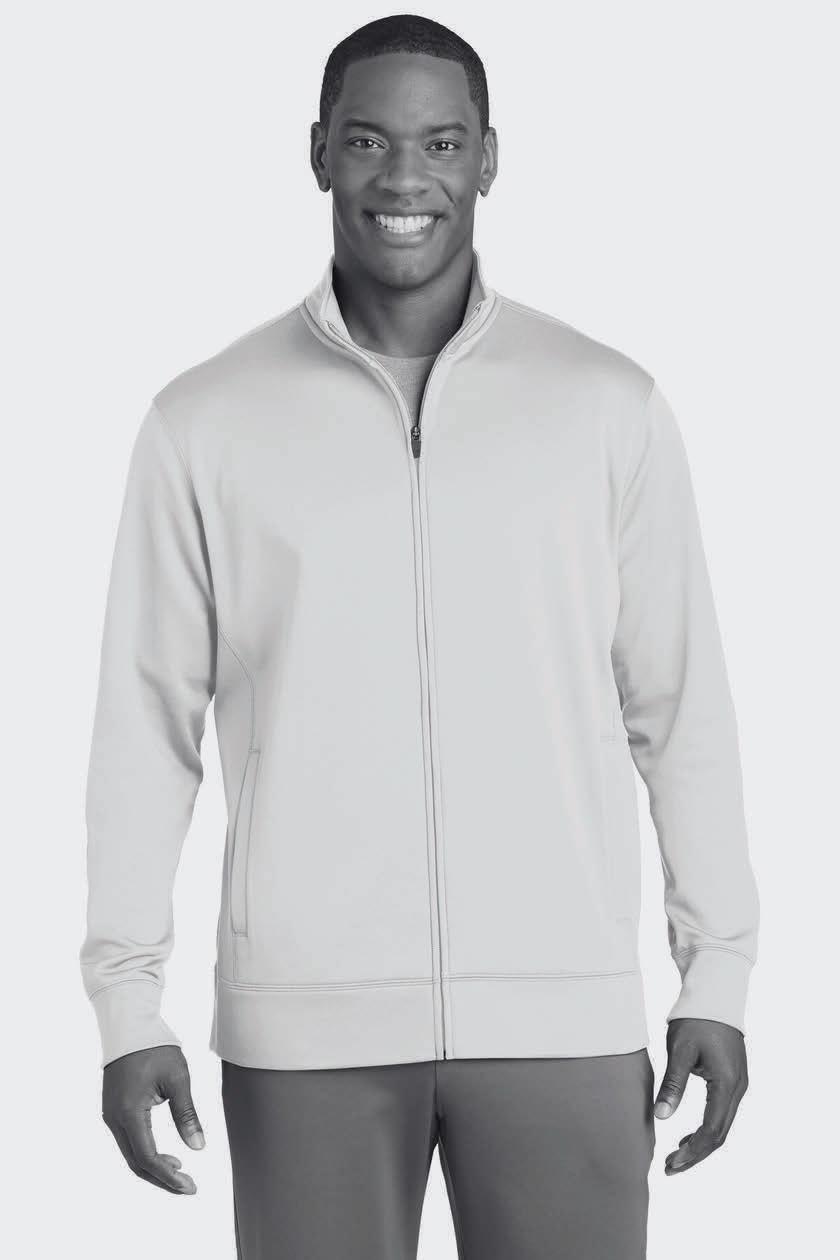





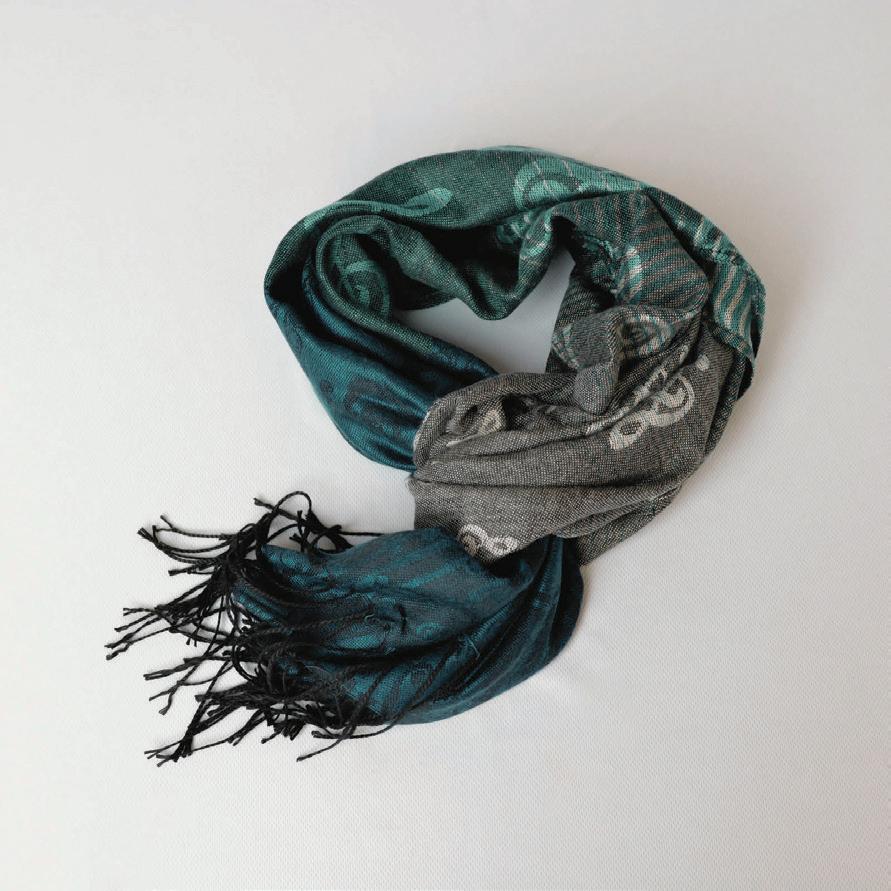
Take the memory home with you.
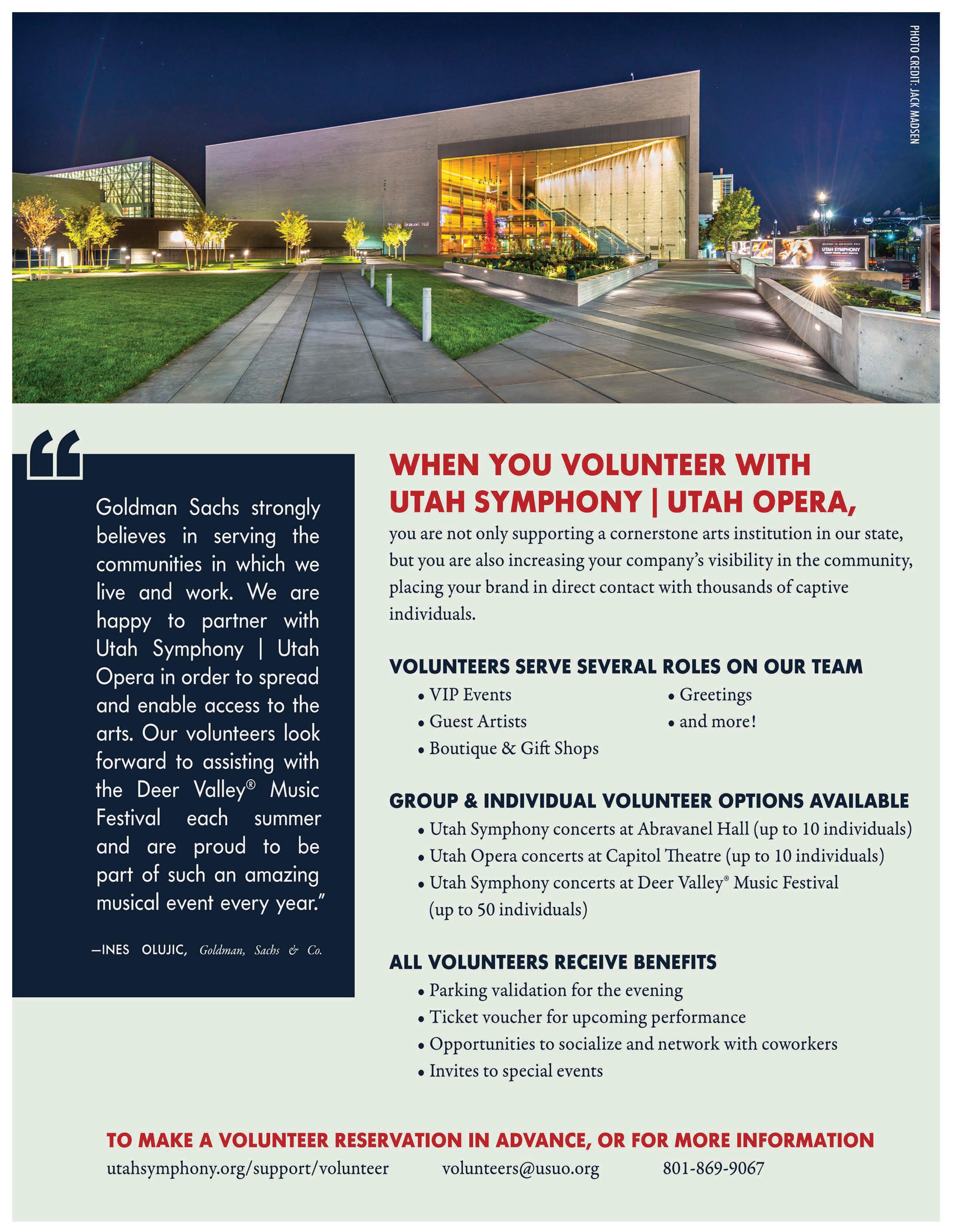
FRIDAY, DECEMBER 12, 2025 / 10 AM / MAURICE ABRAVANEL HALL (FINISHING TOUCHES)
FRIDAY, DECEMBER 12, 2025 / 7:30 PM / MAURICE ABRAVANEL HALL
SATURDAY, DECEMBER 13, 2025 / 7:30 PM / MAURICE ABRAVANEL HALL
PIETARI INKINEN, conductor
SHAI WOSNER, piano
UTAH SYMPHONY
BEETHOVEN
(HANS-WERNER KÜTHEN, ED.) DVOŘÁK
subito con forza (05’)
Piano Concerto No. 3 in C minor, Op. 37 (34’)
I. Allegro con brio
II. Largo
III. Rondo: Allegro
INTERMISSION
Symphony No. 7 in D minor, Op. 70 (38’)
I. Allegro maestoso
II. Poco adagio
III. Scherzo: Vivace
IV. Finale: Allegro
FINISHING TOUCHES SPONSOR


FINNISH CONDUCTOR Pietari Inkinen is recognized internationally for his expressive artistry and technical mastery. He has led many of the world’s leading orchestras, including The Cleveland Orchestra, Royal Concertgebouw Orchestra, Bavarian Radio Symphony Orchestra, Gewandhausorchester Leipzig, Accademia Nazionale di Santa Cecilia, Orchestre Philharmonique de Radio France, Los Angeles Philharmonic, and Helsinki Philharmonic Orchestra.
Inkinen has held chief positions with the Deutsche Radio Philharmonie Saarbrücken Kaiserslautern, Japan Philharmonic Orchestra, Prague Symphony Orchestra, New Zealand Symphony Orchestra, Ludwigsburg Festival Orchestra, and KBS Symphony in Seoul. A talented violinist as well, he studied with Zakhar Bron at the Cologne University of Music before continuing his conducting studies at the Sibelius Academy in Helsinki.

GUEST ARTIST SPONSOR
PIANIST SHAI WOSNER has attracted international recognition for his exceptional artistry, musical integrity, and creative insight. This season, he makes solo appearances with Mason Bates’ Piano Concerto in Italy and Vijay Iyer’s Handmade Universe with East Coast Chamber Orchestra (ECCO) in Seattle. Other highlights include a program with the JACK Quartet at the Frick Collection in New York, the three Brahms violin sonatas with Pinchas Zukerman, and a U.S. tour with Joshua Bell. Shai’s chamber arrangements of various Beethoven symphonies have been premiered and toured by Emanuel Ax, Leonidas Kavakos, and Yo-Yo Ma, and are available in Grammy-nominated recordings released by Sony Classical. His own recordings for Onyx Classics range from Schubert sonatas, to chamber works by Bartók and Kurtág, to concertos by Haydn and Ligeti. He has received Lincoln Center’s Martin E. Segal Award, an Avery Fisher Career Grant, and a Borletti-Buitoni Trust Award.
BY NOEL MORRIS
The Royal Philharmonic Society of London gets props for commissioning great music, including Dvořák’s Seventh Symphony, Mendelssohn’s “Italian” Symphony, Saint-Saëns’ “Organ” Symphony, and Beethoven’s Ninth. Not bad!
Unsuk Chin named her piece subito con forza, an Italian phrase meaning “suddenly, with force,” a tribute to the explosive power of Beethoven.
Ludwig van Beethoven’s Piano Concerto No. 3, his only minor-key piano concerto, pays tribute to his musical hero, echoing the sound and fury of Mozart’s Piano Concerto No. 24.

born July 14, 1961 in Seoul, South Korea
composed in 2020 premiered in Amsterdam, Netherlands on September 24, 2020
The Backstory
In 1798, a Prague critic pilloried Beethoven for his “frequent daring changes from one melody to another.” The critic wrote, “Evils of this nature frequently weaken his greatest compositions.” Of course, Beethoven was just getting started. Living in an era marked by wars, displaced people, and crumbling monarchies, Beethoven gave voice to the upheaval as well as the aspirations and poetry of his time. He broke away from the elegant restraint of the composers who’d come before and lit the way for the composers who’d follow.
The Music
In 2020, Korean composer Unsuk Chin wrote a compact concert opener to commemorate Beethoven’s 250th anniversary. Mingling her endless fascination with musical color with his landmark collection of works, Chin fashioned something that sounds like Beethoven entering The Twilight Zone, or perhaps Beethoven in a blender. Chin gives a nod to the modest, 18th-century orchestra, with pairs of brass and wind instruments, except she enlists the help of a gigantic percussion section. Using a whip, a güiro,
antique cymbals, and more, she puts a 21st-century spin on Beethoven’s habit of making “daring changes.”
In this case, the better you know Beethoven, the more you’ll recognize little fragments of his works flying by. Perhaps the most obvious reference happens around the climax of the piece, when the horns and trumpets sound the famous fournote rhythm that populates the entire Fifth Symphony. Other bits include the “Emperor” Concerto, the Coriolan Overture, the oboe solo from the Fifth Symphony, and the Leonore Overtures.
A Note from the Composer
“Beethoven’s struggle to communicate, and his hearing loss, frequently resulted in an inner rage and frustration. What particularly appeals to me are the enormous contrasts: from volcanic eruptions to extreme serenity. It profoundly and poignantly speaks of something fundamental about the human condition.”

LUDWIG VAN BEETHOVEN
born December 1770 in Bonn, Germany died March 26, 1827 in Vienna, Austria
composed in 1800 premiered in Vienna on April 5, 1803
In 1787, the Austrian emperor’s brother agreed to sponsor 16-year-old Beethoven on a major excursion: the boy would go to Vienna to study with the great musical celebrity Mozart. At that point, Beethoven was already handy as a church organist, a rehearsal pianist, and a string player and harpsichordist in the court orchestra. He was especially dazzling at the piano, a relatively new invention which had only recently become widespread.
In March, the teenager boarded a coach and embarked on a nearly three-week journey to the Austrian capital. It’s possible he met Mozart (reports are unconfirmed), but a message followed him there: his mother lay dying.
Beethoven hurried home, making it back in time to say goodbye. He remained in Bonn for another five years, until he received a second grant allowing him to return to Vienna. By that time, Mozart had died, and Haydn was to be his teacher—not a particularly good fit. The two composers had a series of strained meetings, but the taste of success quickly turned Beethoven’s head.
Almost immediately, he started teaching and performing in palaces around Vienna. Gaining a reputation for thundering piano playing, he wrote piles of piano music to show off his skill, but rarely performed in public.
The Music
In 1800, more than seven years after he arrived in the Austrian capital, he organized a public performance before the Viennese. Billed as a concert “for his own benefit,” Beethoven premiered his First Symphony, conducted music by Haydn and Mozart, and played one of his own piano concertos. He had intended to premiere his stormy Third Piano Concerto that night, but the piece wasn’t ready—and it wouldn’t be for another three years.
Finally, at 8 AM on April 5, 1803, Beethoven assembled a ragtag orchestra and chorus and began rehearsing. A grueling ten-hour affair, the rehearsal ended shortly before the doors opened for the 6 PM concert. Beethoven, himself, played the solo part of his Third Piano Concerto. Ignaz von Seyfried, a young conductor, stood at his side to turn pages and left the following account:
I saw almost nothing but empty leaves; at the most, on one page or another a few Egyptian hieroglyphs, wholly unintelligible to me, were scribbled down to serve as clues for him; for he played nearly all of the solo part from memory since, as was so often the case, he had not had time to set it all down on paper. He gave me a secret glance whenever he was at the end of one of the invisible passages, and my scarcely concealable anxiety not to miss the decisive moment amused him greatly. He laughed heartily during the jovial supper which we ate afterwards.

born September 8, 1941 in Nelahozeves, Bohemia died May 1, 1904 in Prague, Bohemia
What to listen for
Notice the way Antonín Dvořák spins the opening theme of the Seventh Symphony into an entire movement, with rhythms and bits of the tune returning throughout.
Symphony No. 7
composed 1884–1885 premiered in London on April 22, 1885
For the better part of four decades, Antonín Dvořák was desperately poor. Making his way in Prague, he lived with relatives while studying music, teaching, and playing viola. In 1873, with a baby on the way, he married and took a job as a church organist. Baby Otakar arrived in April of 1874, and a special opportunity presented itself: a cash prize for a demonstrably poor and gifted musician. Dvořák was so qualified that he won the award five consecutive years. And the contest brought him face-to-face with one of its judges: Johannes Brahms.
Brahms knew Dvořák was a major talent and introduced him to his own publisher, Fritz Simrock. Simrock took a chance on the no-name guy from rural Bohemia and made a small fortune.
The encounter came amid tensions in the Austrian Empire. The German-speaking majority treated the Czech people as second-class citizens. Authorities subjected them to Germanization policies, banning the Czech language for a time and forcing their conversion from Protestantism to Catholicism. Even Simrock took the low road by refusing to print Dvořák’s real name (he changed it from Antonín to Anton).
As it turned out, the English marketplace had a taste for the piquant sounds of this new Bohemian, minus the prejudice. The Philharmonic Society of London sponsored some Dvořák concerts and brought the composer across the Channel, farther than he’d ever traveled.
“If all the Czech inhabitants of the whole of Bohemia were put together, they would not number as many as the inhabitants of London,” Dvořák marveled.
Apparently, the wonder went both ways. In the wake of a successful trip, the Philharmonic Society invited him to become a member and commissioned the Seventh Symphony for the following season.
Now in the international spotlight, the composer had a lot riding on this new piece and wanted to infuse it with the kind of weight and gravitas he might have expected from his friend Brahms. Several months passed before he got into “the zone.” Then, on a chilly December day in 1884, Dvořák went train spotting—a favorite hobby—and spotted a lively group of anti-imperialists arriving on the train from Pest. In that moment, a tune popped into his head. And it hit him—like the opening words of an essay. Suddenly, his
pen could barely keep pace with the music playing in his head. He completed the symphony in three months.
The Seventh Symphony is Dvořák’s darkest and heaviest—and many believe his greatest—symphony. But his “Czechness” filters through, especially in the third movement, written in the style of a peasant dance called the furiant. The 6/4 meter gives an off-kilter feeling to this whirling flight of fancy.
Dvořák’s popularity exploded between his first and second visits to the U.K. Biographer Neil Wenborn wrote, “There, to
his astonishment, the composer found his portrait for sale in all the bookshops and was besieged by autograph-hunters in the street.”
Dvořák led the Royal Philharmonic in the premiere of his Symphony No. 7 on April 22, 1885, and the Londoners cheered.
“There was pandemonium after every movement, rousing to the very end, just like at home.”
—Antonín Dvořák



THURSDAY, DECEMBER 18, 2025 / 7:30 PM / BROWNING CENTER AT WEBER STATE UNIVERSITY, AUSTAD AUDITORIUM
FRIDAY, DECEMBER 19, 2025 / 7:30 PM / MAURICE ABRAVANEL HALL
SATURDAY, DECEMBER 20, 2025 / 7:30 PM / MAURICE ABRAVANEL HALL
LUCAS WALDIN, conductor
CAPATHIA JENKINS, vocalist
RYAN SHAW, vocalist
UTAH SYMPHONY
BRUCE BROUGHTON
STEVE ALLEN
BERNARD / DICK SMITH
HATHAWAY / MCKINNOR
TORMÉ / WELLS
IRVING BERLIN
STANLEY / BROOKS / TAYLOR
MILLER / WELLS
STORY / GAYE / GORDY
TRADITIONAL
CAREY / AFANASIEFF
Overture to Miracle on 34th Street
“Cool Yule”
“Winter Wonderland”
“This Christmas”
“The Christmas Song” (“Chestnuts Roasting on an Open Fire”)
“Holiday Medley”
“(Everybody’s Waitin’ for) The Man With the Bag”
“Someday at Christmas”
“What Christmas Means to Me” “God Rest Ye Merry Gentlemen”
“All I Want for Christmas”
INTERMISSION
JIM STEPHENSON III
SHELTON / STEFANI / BUSBEE / TRANTER
FOSTER / THOMPSON-JENNER
LEROY ANDERSON
TRADITIONAL
TRADITIONAL
LOWRY / GREENE
ADOLPHE ADAM
VARIOUS
Holiday Fanfare No. 1
“You Make It Feel Like Christmas”
“Grown-Up Christmas List”
Sleigh Ride
Appalachian Carol
A Christmas Scherzo
“Mary, Did You Know?”
“O Holy Night”
Christmas Carol Sing-Along



LUCAS WALDIN IS A DYNAMIC AND VERSATILE CONDUCTOR whose performances have delighted audiences across North America. He has collaborated with some of today’s most exciting artists including Carly Rae Jepsen, The Barenaked Ladies, Crash Test Dummies, Ben Folds, The Canadian Brass, and Buffy Sainte-Marie, in addition to conducting presentations such as Disney in Concert, Blue Planet Live, Cirque de la Symphony, and the groundbreaking symphonic debut of R&B duo Dvsn as part of the global Red Bull Music Festival.
Waldin has been a guest conductor for numerous orchestras in the U.S. and Canada, including The Cleveland Orchestra, St. Louis Symphony, Houston Symphony, Dallas Symphony, Grant Park Festival Orchestra, Vancouver Symphony, Calgary Philharmonic, Toronto Symphony, and National Arts Centre Orchestra.
A native of Toronto, Ontario, Waldin holds degrees in flute and conducting from the Cleveland Institute of Music.
AN ACTIVE CONCERT ARTIST, CAPATHIA JENKINS has appeared with numerous orchestras around the world including the Cleveland Orchestra, Houston Symphony, Chicago Symphony, Pittsburgh Symphony (with Marvin Hamlisch), National Symphony, Cincinnati Pops (with John Morris Russell), Philly Pops, San Francisco Symphony, San Diego Symphony, the Hong Kong Philharmonic, and many others. She was also a soloist with the Festival Cesky Krumlov in the Czech Republic multiple times. In October 2025, Jenkins will travel to Bratislava to perform at the Concert Hall of the Slovak Philharmonic. Jenkins had the great honor of performing in the ‘Broadway Ambassadors to Cuba’ concert as part of the Festival De Teatro De La Habana. She has performed at Carnegie Hall with the New York Pops multiple times and also sang in a Tribute to Marvin Hamlisch at the Library of Congress.
RYAN SHAW IS A THREE-TIME GRAMMY® NOMINATED ARTIST for his solo projects. He has shared the world stage with such artists as Van Halen, Bonnie Raitt, John Legend, and B.B. King. His music has been featured in well-known TV shows and films. He has starred on Broadway, on London’s West End, at Radio City Music Hall, and on such renowned stages as Carnegie Hall, the Kennedy Center, NY’s Central Park, and with major orchestras throughout North America. Shaw currently headlines several pops orchestra shows, including his own R&B Legends with RYAN SHAW, and the duo show with Capathia Jenkins, ICON –The Voices That Changed Music. He just returned from Berlin performing the role of Judas in a sold-out production of the Komische Oper Berlin’s Jesus Christ Superstar. His album, Imagining Marvin, showcases Marvin Gaye hits alongside Shaw’s original songs. His newest single, “Rising Up,” is an inspirational call to action. Simultaneously, Shaw recently released a new duo album with Ray Angry entitled OFF Broadway.

WE ASKED MEMBERS of Utah Symphony | Utah Opera to share some of their favorite traditions during the winter holiday season–in addition to playing for you! Here’s what they told us:
I love the Chinese New Year. I remember when my whole family used to gather together. My grandma and my aunt cooked many yummy dishes like steamed dumplings, soy sauce chicken, scallion steam fish, and spring vegetables. Then, later in the evening, we set up the firecrackers. That was the most fun for the kids!
Wen Flatt, Violin Utah Symphony
My family’s holiday tradition is watching The Muppet Christmas Carol every Christmas Eve. We’ve done this my entire life, so I’ve seen this movie over 30 times. Now, when we watch it, it’s less watching the movie, and more saying every line and singing every song verbatim.
Anna Thompson, Associate Principal Librarian Utah Symphony
My family has continued a tradition that my wife grew up with. We always have waffles and strawberries for breakfast on Christmas morning. One of my favorite holiday seasonal songs is “Have Yourself a Merry Little Christmas,” written in the midst of World War II. If it’s sung well, this line always gets me: “Until then, we’ll have to muddle through, somehow.”
Kevin Shumway, Cello Utah Symphony


Holiday traditions are about getting together with family whenever possible and good friends. Actually, it’s all about the food. It’s the meal that sustains and attracts people. As a family, we like to cook and whip up these festive dinners that will include something for everyone. For our meat eater friends, I am known for a holiday brisket that cooks forever in wine and cranberry juice. I make challah (a traditional braided brioche-like bread) and that is always a hit with our kids. My husband, Tad, whips up some amazing mashed potatoes and, of course, his famous pies! So next time you’re in the area, stop by!
Lynn Rosen, Violin (married to Utah Symphony Principal Clarinetist, Tad Calcara)
Utah Symphony
One of my favorite classic winter works is Tchaikovsky’s The Nutcracker, which never fails to put me in the holiday


I have wonderful childhood memories of going to my grandparents’ house for Christmas. Despite a recent 23andMe test that has revealed that I’m mostly Northern European, my family has kept many of our Czech traditions alive. I have fond memories of starting the day with apricot or plum kolaches, playing a card game called Tarrocks which uses a proprietary deck, and making a huge apple strudel, many hands around the table stretching the dough paper thin and filling it with fillings and rolling it with the aid of a bed sheet.
Erin Svoboda-Scott, Associate Principal Clarinet Utah Symphony
My wife and I play Christmas duets on glockenspiel and violin. (She’s a scientist, but played violin in high school.) I beat time with jingle bells on my ankles to keep us in sync. Since we traditionally go to North Carolina for Christmas, we bought a cheap bell kit for traveling, giving the Christmas sound some extra spirit.
Eric Hopkins, Associate Principal Timpani Utah Symphony
One of my favorite holiday traditions is I do a concert with my family every year. My family all sing and play various instruments, and we pull from our extended family and friends and we usually have some sort of theme. We do it at my grandparents’ church, where my mother grew up, and where I attended as a child. This year, we are doing an English Lessons and Carols sort of structure, and my grandfather is narrating. We love to do a lot of Anglican carols, as well as taking requests for favorite carols from different members of our community. And then we have food after and go to the park and look at Christmas lights. It’s really wonderful to have years of memories with our family and friends, and to really feel the spirit of the holidays with everyone.
Deborah Robertson, Principal Coach
Utah Opera


TUESDAY, DECEMBER 16, 2025 / 7 PM / UVU NOORDA CENTER FOR THE PERFORMING ARTS
SATURDAY, DECEMBER 20, 2025 / 11 AM / MAURICE ABRAVANEL HALL
SATURDAY, DECEMBER 20, 2025 / 12:30 PM / MAURICE ABRAVANEL HALL
JESSICA RIVERO ALTARRIBA, conductor ELLESSE HARGREAVES, actor
KAITLIN MILLS, actor
UTAH SYMPHONY
ANDERSON
TRADITIONAL
(ARR. CHRIS RIDENHOUR)
NELSON
(ARR. BILL HOLCOMBE)
TCHAIKOVSKY
TCHAIKOVSKY
SOWANDE
DILORENZO
BASS
ANDERSON
A Christmas Festival
“We Wish You a Merry Christmas”
“Frosty the Snowman”
“Tea (Chinese Dance)” from The Nutcracker Suite, Op. 71a
“Chocolate (Spanish Dance)” from The Nutcracker, Op. 71
“Joyful Day” from African Suite for string orchestra
Navidad Latina
The Night Before Christmas
Sleigh Ride
CONDUCTOR SPONSOR
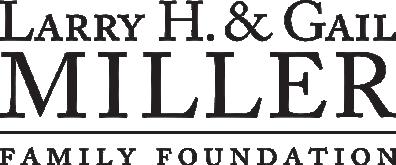


PLEASE SEE JESSICA RIVERO ALTARRIBA’S BIO ON PAGE 22.
KAITLIN MILLS is thrilled to return for her fourth year as Noelle in Here Comes Santa Claus. Her previous credits include A Midsummer Night’s Dream, The Comedy of Errors, and Amadeus at the Utah Shakespeare Festival, as well as Pericles with Women of Will. Mills has a bachelor’s degree in Classical Acting and a master’s in Arts Administration from Southern Utah University. She is delighted to return to the stage again to spread some Christmas cheer!
ELLESSE HARGREAVES is delighted to share the stage with such extraordinary artists and musicians. Though much of her work unfolds behind the scenes, she has proudly collaborated with Utah Symphony | Utah Opera for nearly fifteen years. Having studied theatre at Southern Utah University, Ellesse has appeared in numerous local productions, including work with Salt Lake Acting Company and Riot Act Theatre. She has written and performed in several of the Utah Symphony’s family productions, including Here Comes Santa Claus, Symphonic Space Adventure (2024), and Halloween Spooktacular (2024). Ellesse offers her love and gratitude to her nieces and nephews for their endless inspiration and writing material—and to her family and husband, Jeff, for their constant support.

At Residence Inn by Marriott® Salt Lake City, Downtown, we provide spaces and experiences that allow you to travel like you live. Enjoy a variety of amenities including outdoor spaces with fire pits and grills; and our seasonal Outdoor Pool. Start each day off right with our hot breakfast and Wi-Fi. Plus, head outdoors and get moving with access to outdoor parks and trails all within minutes. See why The Residence Inn SLC Downtown is your perfect home away from home today by visiting w ww.marriott.com/slcri.
Residence Inn Salt Lake City Downtown Marriott.com/SLCRI
THURSDAY, JANUARY 8, 2026 / 7:30 PM / UVU NOORDA CENTER FOR THE PERFORMING ARTS
FRIDAY, JANUARY 9, 2026 / 7:30 PM / MAURICE ABRAVANEL HALL
SATURDAY, JANUARY 10, 2026 / 5:30 PM / MAURICE ABRAVANEL HALL
DELYANA LAZAROVA , conductor AWADAGIN PRATT, piano UTAH SYMPHONY
TCHAIKOVSKY
UVUU NOORDA CENTER
Presidential Concert in Honor of Dr. Astrid Tuminez
Fantasy for Orchestra, Op. 7 “The Rock” (13’)
Piano Concerto No. 23 in A major, K. 488 (26’)
I. Allegro
II. Adagio
III. Allegro assai
INTERMISSION
Symphony No. 1 in G minor, Op. 13 “Winter Dreams” (43’)
I. Allegro tranquillo
II. Adagio cantabile ma non tanto
III. Scherzo: Allegro scherzando giocoso
IV. Finale: Andante lugubre - Allegro moderato - Allegro maestro
CONCERT SPONSOR
UVU NOORDA CENTER GUEST ARTIST SPONSOR


DELYANA LAZAROVA is Principal Guest Conductor of the Utah Symphony, where she programs wide-ranging repertoire influenced by her international musical education. Born in Bulgaria, she has a natural affinity for Eastern European and Russian repertoire but feels equally at home in the Viennese Classical period, influenced by her studies in Switzerland. She is passionate about music from the 20th and 21st centuries.
Lazarova has won conducting competitions and prizes worldwide and was assistant to Sir Mark Elder and Cristian Măcelaru. She is also an accomplished violinist with a master’s degree from the Jacobs School of Music in Indiana.
In addition to conducting multiple Utah Symphony concerts this season, she will serve as Principal Guest Conductor of BBC Scottish Symphony Orchestra. Debuts in 2025–26 include the BBC Proms with BBC Scottish Symphony, Colorado Symphony, Orchestre Symphonique de Quebec, Madrid’s Orquesta Sinfonica y Coro de RTVE, Orquesta Sinfónica de Galicia, and Yomiuri Nippon Symphony Orchestra. She returns to the Oregon Symphony Orchestra, Minnesota Orchestra, Orchestre Philharmonique de Strasbourg, and Munich Chamber Orchestra, and embarks on a European tour with Kammerorchester Basel.
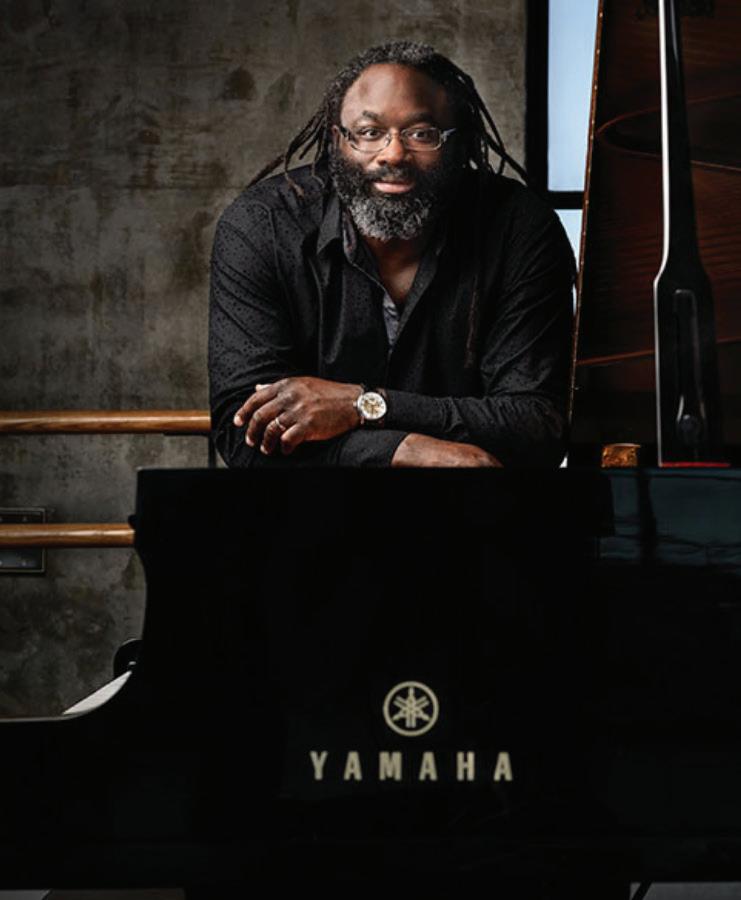
THROUGH HIS kaleidoscopic career as a pianist, conductor, educator, and curator of memorable musical moments, Awadagin Pratt shines a light on voices of the past and present, amplifies the diverse talents of today’s brightest creative minds, and paves the way for a new generation of inventive musical artists.
Since winning the Naumburg International Piano Competition in 1992 and receiving a 1994 Avery Fisher Career Grant, Pratt has received acclaim for delivering “forceful, imaginative, and precisely tinted” performances (The Washington Post) and been hailed as “one of the great and distinctive American pianists and conductors of our time” (WGBH). He has appeared at addresses as familiar as 1600 Pennsylvania Avenue (at the invitation of the Clinton and Obama administrations) and Sesame Street (at the invitation of Big Bird). He has performed with the Boston and Chicago Symphony Orchestras, the New York Philharmonic, and many others; and in solo recitals at The Kennedy Center, Carnegie Hall, and Lincoln Center.

BY NOEL MORRIS
In a revealing statement, Rachmaninoff offered insight into three of the creative minds behind this concert: “To [Tchaikovsky] I owe the first and possibly the deciding success in my life. [He] at that time was already worldfamous…but he remained unspoiled. He was one of the most charming artists and men I ever met. He had an unequaled delicacy of mind. He was modest, as all really great people are, and simple, as very few are. (I met only one other man who at all resembled him, and that was [Anton] Chekhov).”
Through the 1780s, Wolfgang Mozart was a freelance musician and bon vivant living in Vienna. He supported his party habit and growing family by writing and performing piano concertos.
Young Tchaikovsky labored over his First Symphony between 1866 and 1868. Chain-smoking all the way, long months of sleepless nights led to panic attacks. After that, he resolved not to work at night.
What to listen for
Both Rachmaninoff and Tchaikovsky evoke a winter scene in a Russian forest.

SERGEI RACHMANINOFF
born April 1, 1873 in Semyonovo, Russia died March 28, 1943 in Beverly Hills, California
The Rock composed in 1893 premiered in St. Petersburg, Russia in 1894
The Backstory
In 1885, 12-year-old Sergei Rachmaninoff moved in with young students and the famed piano teacher Nikolai Zverev. Professor Zverev provided lessons, room and board, concert tickets, and a “hard smack” whenever deemed necessary. The boys received world-class training and an introduction to an elite circle of artists that included people like Tchaikovsky and, later, the playwright Anton Chekhov. Rachmaninoff idolized them both.
Fast-forward to April 1893 when the Bolshoi Theatre produced Rachmaninoff’s opera Aleko—an astonishing achievement for any composer, let alone a 20-year-old. Flush with success, he spent the summer with friends in the country where he wrote his first symphonic poem, The Rock, based on the Chekhov short story On the Road
In the fall, a friend invited Rachmaninoff to an intimate gathering where Tchaikovsky previewed his Sixth Symphony (a two-piano arrangement). Things got tense as the arrangement required numerous corrections. But then the friends handed the night’s entertainment over to young Rachmaninoff, who played through his new tone poem, The Rock. Tchaikovsky lit up. He was so pleased with the piece, he offered to conduct the premiere and take it on the road. Sadly, Tchaikovsky succumbed to cholera a few months later, and the tour never happened. Rachmaninoff sat down and composed the Trio élégiaque in memory of him.
As for The Rock, the composer left us with a mystery. Chekhov included a line of poetry by Mikhail Lermontov at the top of his story, On the Road
“Upon the breast of a gigantic rock, A golden cloudlet rested for one night.”
Rachmaninoff included the same line at the top of his score, leading people to believe that the line provided the program to the symphonic poem. In fact, his piece follows Chekhov’s tale about two strangers stranded together in a tavern overnight. Oddly enough, Rachmaninoff kept the source of his tone poem secret until finally presenting the published score of The Rock to Chekhov with the following inscription:
“To dear and highly esteemed Anton Pavlovich Chekhov, the author of the story ‘Along the Way,’ the contents of which, with the same epigraph, served as the program for this musical composition.”
S. Rachmaninoff November 9, 1898
Synopsis
A mixed group of snowbound travelers huddles around a roaring fire at a roadside tavern. As the storm swipes at the windows, a 42-year-old wanderer named Grigory corners a noblewoman half his age and tells her his life story. He explains that he was born into a noble family and confesses to having cheated, abandoned, and disappointed everyone
he’s ever loved. She takes pity on him. In the morning, the travelers prepare to resume their journeys. Grigory and the young maid exchange a thoughtful gaze. For a heartbeat, she contemplates running away with him, but turns and leaves Grigory transfixed like a rock in the driving snow.

born January 27, 1745 in Salzburg, Austria died December 5, 1791 in Vienna, Austria
composed in 1786
premiered in Vienna in 1786
The Backstory
Leopold Mozart raised two prodigies, Wolfgang and his sister, Nannerl. And Leopold knew just how to leverage their talent, serving as a teacher and business manager. Traveling from city to city, the Mozart children dazzled Europe’s elite. And the money flowed. Although he was but a servant back home in Salzburg (a musician ranked beneath a valet), Leopold bought a private carriage and even hired servants of his own. As Wolfgang matured, Papa Mozart nurtured his own vision of a bright future, one that would be paid for by his genius son.
In 1777, he sent 21-year-old Wolfgang on a job-hunting tour around various European courts. Leopold told Mozart’s mother and chaperone to keep their son away from women. In truth, Wolfgang Mozart had spent his entire life fraternizing with the nobility and was not cut out to be anyone’s servant.
He first made rumblings of going freelance when he fell in love with Aloysia Weber, who lived in Mannheim. Leopold put the kibosh on that and ordered him back to Salzburg. Things finally came to a head in 1781, and the younger Mozart managed to escape.
The Music
Wolfgang settled in Vienna, where he fell in love with Constanze Weber, Aloysia’s younger sister. He wrote to Leopold, asking for permission to marry her, prompting an icy rejection. Defying his father, Mozart married Constanze and started a family in 1782. He supported them by writing and performing his own piano concertos.
Keep in mind that Mozart lived during the waning years of the Holy Roman Empire, which regarded the theater as a lewd and sensuous pleasure, prohibited the staging of operas during Lent. Capitalizing on the prohibition, Mozart hosted lucrative subscription concerts during the Lenten season, featuring himself at the piano.
Mozart and Constanze fell into Vienna’s beau monde, spending lavishly and partying through the night. At the end of 1785, he started work on his scandalous opera The Marriage of Figaro. At the same time, he tossed off the oneact comic opera The Impresario. He also wrote three piano concertos for the upcoming Lenten season, completing the Piano Concerto No. 23, K. 488, on March 2, 1786.
Of the three concertos, K. 488 is the most intimate, without trumpets or timpani. It’s hard to think of more genial music than its two outer movements, while the inner movement touches the soul with an operatic sense of lonesome melancholy. The famous 20th-century composer Olivier Messiaen wrote that the concerto “ranks right up there with all piano concertos; it is surely the most perfect of them all, if not the most beautiful.”

PYOTR ILYICH TCHAIKOVSKY
born May 7, 1840, Votkinsk, Russia died November 6, 1893, St. Petersburg
composed in 1866–1868 premiered in Moscow on February 15, 1868
The Backstory
Much has been written about Pyotr Ilyich Tchaikovsky and his fragile temperament. But he was downright bold when he dared to write a symphony. He’d entered the conservatory a full century after Haydn started writing symphonies. Mozart, Beethoven, and many others famously followed in kind without a symphonic peep from Russia. Isolationism ruled Tchaikovsky’s world; zealous patriots condemned European music as foreign and corrupt. In a fractious atmosphere, Russian composers didn’t produce symphonies until the 1860s. Twenty-six-year-old Tchaikovsky was one of the first. In fact, he was one of the first to attend a conservatory.
At age 10, his parents sent him to boarding school. He graduated with a law degree and landed a job at the Ministry of Justice. When the St. Petersburg Conservatory opened in 1862—the first of its kind in Russia—he quit his job to become a full-time music student. By graduation, Tchaikovsky had premiered some short pieces and a cantata. A second conservatory opened its doors and hired him as a professor on the spot.
Stepping into the symphonic arena, young Tchaikovsky embarked upon a 45-minute piece. It was like shifting from writing (mostly) short stories to a full-fledged novel. He resolved to strike a balance in that politically charged atmosphere: to be worthy of his European predecessors while advancing some authentic yet undefined sense of “Russian-ness.”
In December 1866, he showed his new symphony to his former professors, but they only liked the Adagio and Scherzo. Tchaikovsky pressed ahead. The complete symphony premiered in 1868 (rev. 1874), followed by the successful premiere of his Second Symphony in 1872.
Tchaikovsky’s identity as a Russian proved inseparable from his music. The folk songs of his youth and his impressions of a Russian winter guided his hand in the First Symphony. The first movement, “Dreams of a Winter Journey,” evokes the sound of a sleigh ride. The second movement, “Land of Gloom, Land of Mists,” is closely tied to the countryside. The third movement, marked Allegro scherzando giocoso, indicates a fast, playful, and joking style, while the finale features an actual folk song.

Utah Opera Sponsors - Fidelio
PRESENTING SPONSOR
PRODUCTION SPONSOR
OPERA ARTISTIC DIRECTOR SPONSOR
VIP INTERMISSION RECEPTION SPONSOR

FLORAL SEASON SPONSOR
VIP INTERMISSION BEVERAGE SPONSOR

CAST PARTY SPONSOR

JANUARY 17 (7:30PM), JANUARY 19 (7 PM), JANUARY 21 (7 PM), JANUARY 23 (7:30PM), JANUARY 25 (2 PM) JANET QUINNEY LAWSON CAPITOL THEATRE
Composed by Ludwig van Beethoven with Libretto by Joseph Sonnleithner Premiere – November 20, 1805. Theater an der Wien, Vienna. Previously at Utah Opera – 2011, 1999 Performed in German and English with English Supertitles (Captions)
(in order of vocal appearance)
The Oracle ............................................ Sharlene Wells
Jaquino Aaron McKone*
Marzelline Stephanie Chee*
Leonore (Fidelio) ................................... Wendy Bryn Harmer
Rocco David Soar
Don Pizarro
Zachary Nelson
Florestan Limmie Pulliam
Don Fernando Rodney Sharp II*
Conductor Benjamin Manis
Stage Direction & Original Concept Tara Faircloth
Chorus Director & Assistant Conductor ................... Austin McWilliams
Projection Designer Sarah Tundermann
Costume Designer Fan Zhang
Lighting Designer ......................................... Eric Watkins
Wig & Makeup Designer Kate Casalino
Principal Coach Deborah Robertson
Rehearsal Pianist ....................................... Jie Fang Goh*
Assistant Director Matthew J. Schulz
Assistant Lighting Designer Ari Jamieson
Stage Manager ...................................... Kathleen Edwards
Assistant Stage Manager Ezra Rose & Ellie Brown
Supertitle Musician Ashley Tingey
Set and costumes built by Utah Opera Supertitle translation by Tara Faircloth
The performance run time is approximately 2 hours 30 minutes with one intermission.
*Current Resident Artist

Kate Casalino (New York)
Wig & Makeup Designer
Most Recently at Utah Opera, The Shining Recently: I & You, McCarter Theater
Head Over Heels, Forestburgh Playhouse Upcoming: Noises Off, Pioneer Theatre Company

Tara Faircloth (Texas)
Stage Direction & Original Concept
Most Recently at Utah Opera, Pagliacci
Recently:
Loving Clara Schumann (original creation), Mercury Chamber Orchestra
Roméo et Juliette, Palm Beach Opera
Upcoming:
Elmer Gantry, Opera Santa Barbara

Stephanie Chee (California) Marzelline
Most Recently at Utah Opera, The Shining Recently:
Utah Opera Resident Artist
The Rape of Lucretia, The Shepherd School of Music L’incoronazione di Poppea, The Shepherd School of Music Upcoming:
The Elixir of Love, Utah Opera

Wendy Bryn Harmer (California) Leonore (Fidelio)
Most Recently at Utah Opera, Der fliegende Holländer Recently:
The Turn of the Screw, The Righteous, The Santa Fe Opera
Der fliegende Holländer, Staatsoper Hamburg, Teatro Municipal de Santiago Turandot, Lyric Opera of Kansas City
Upcoming:
Elektra, Teatro Municipal de Santiago Idomeneo, Boston Baroque

Benjamin Manis (Illinois)
Conductor
Most Recently at Utah Opera, Madame Butterfly
Recently:
The Ghosts of Versailles, Rice University
Carmen, San Francisco Opera
Upcoming:
Of Mice and Men, Houston Grand Opera
The Barber of Seville, San Francisco Opera

Austin McWilliams (Missouri)
Chorus Director & Assistant Conductor
Most Recently at Utah Opera, The Shining
Recently:
Associate Conductor & Chorus Master, Opera Grand Rapids
Director of Choral Activities, Aquinas College
Upcoming:
Cantata misericordium, The Cathedral of the Madeleine
Utah Symphony | Utah Opera 2025–2026 Season

Aaron McKone (South Carolina)
Jaquino
Most Recently at Utah Opera, The Shining
Recently:
Utah Opera Resident Artist
Madame Butterfly, Utah Opera
Pagliacci, Utah Opera
Hamlet, Cincinnati Symphony Orchestra
Upcoming:
La traviata, Utah Opera
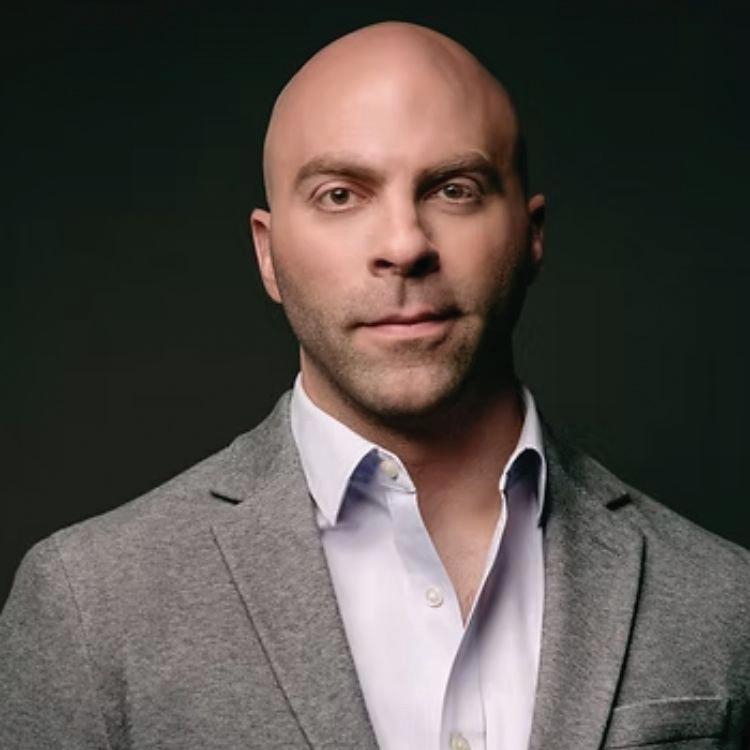
Zachary Nelson (New Mexico)
Don Pizarro
Utah Opera debut
Recently:
La bohème, Pittsburgh Opera
Bluebeard’s Castle, Opera San José
Upcoming:
Madama Butterfly, Lyric Opera of Chicago

Limmie Pulliam (Missouri)
Florestan
Utah Opera debut
Recently:
Das Lied von der Erde, The Cleveland Orchestra
Turandot, Minnesota Orchestra
Upcoming:
Mahler’s Symphony No. 8, Dallas Symphony Orchestra

David Soar (California)
Rocco
Most Recently at Utah Opera, Sweeney Todd
Recently:
Parsifal, San Francisco Opera
Turandot, Lyric Opera of Kansas City
Das Rheingold, Opéra de Monte-Carlo

Rodney Sharp II (Texas)
Don Fernando
Most Recently at Utah Opera, The Shining
Recently:
Utah Opera Resident Artist
Madame Butterfly, Utah Opera
Upcoming:
La traviata, Utah Opera

Sarah Tundermann (Maryland)
Projection Designer
Utah Opera debut
Recently:
Otello, Maryland Lyric Opera
Falstaff, Maryland Lyric Opera
Un ballo in maschera, Maryland Lyric Opera
Don Carlo, Maryland Lyric Opera
America’s Requiem: A Knee on the Neck (world premiere), National Philharmonic

Eric Watkins (Illinois)
Lighting Designer
Utah Opera debut
Recently:
The Barber of Seville, Minnesota Opera
La bohème, Opera San José
Upcoming:
Mary Jane, Northlight Theatre

Fan Zhang (Utah)
Costume Designer
Utah Opera debut
Recently:
The Tin Angel, Teatro Grattacielo

Sharlene Wells (Utah)
The Oracle
Utah Symphony | Utah Opera Board Member
Senior Vice President of Mountain America Credit Union
Achievements of Note:
Utah Business magazine “Woman of the Year,” 2024
Appointee by Secretary of Defense, 2015
Emmy-nominated ESPN Sports Broadcaster, 1987–2002
Miss America, 1985

December 17
Clubhouse SLC
December 19-20
Park City Community Church
parkcityopera.org



Soprano
Rebekah Barton Stockton
Lindsay Browning
Alto
Melissa James
Jamie Johnson
Tenor
Drake Bennion
Trevor Blair
Dyson Ford
Orion Gray
Bass
Buddy Eyre
Ryan Francis
Rodrigo Hernandez-Vazquez
Seth Jensen
Supernumeraries
Vivien Browning
Rose Burrell
Bradley Christensen
Anadine Burrell
Kahli Dalbow
Genevieve Gannon
Kate Olsen
Angela Keeton
Samantha Lange
Julie McBeth
Alice Packard
Elijah Hancock
Tim Hanna
Jacob Kenison
Isaac Lee
Layton Loucks
Daniel McDonnall
Lucas Henry Proctor
Utah Opera Chorus / Supernumeraries
Larissa Olson
Carolyn Talboys-Klassen
Claire Phillips
Dawn Veree
Thomas Klassen
Nelson LeDuc
Lyman Moulton
Michael Moyes
Jenny Evans
Iris Lange
Roland Lange
Vincent Nguyen
Richard Olsen
Oscar Safsten
Logan Reid
Scott Tarbet
William Tepner
Carson Smith
Mark Sorensen
Daniel Tu’utau
James Ohman
Jacob Olson
George Phillips
Paul Phillips
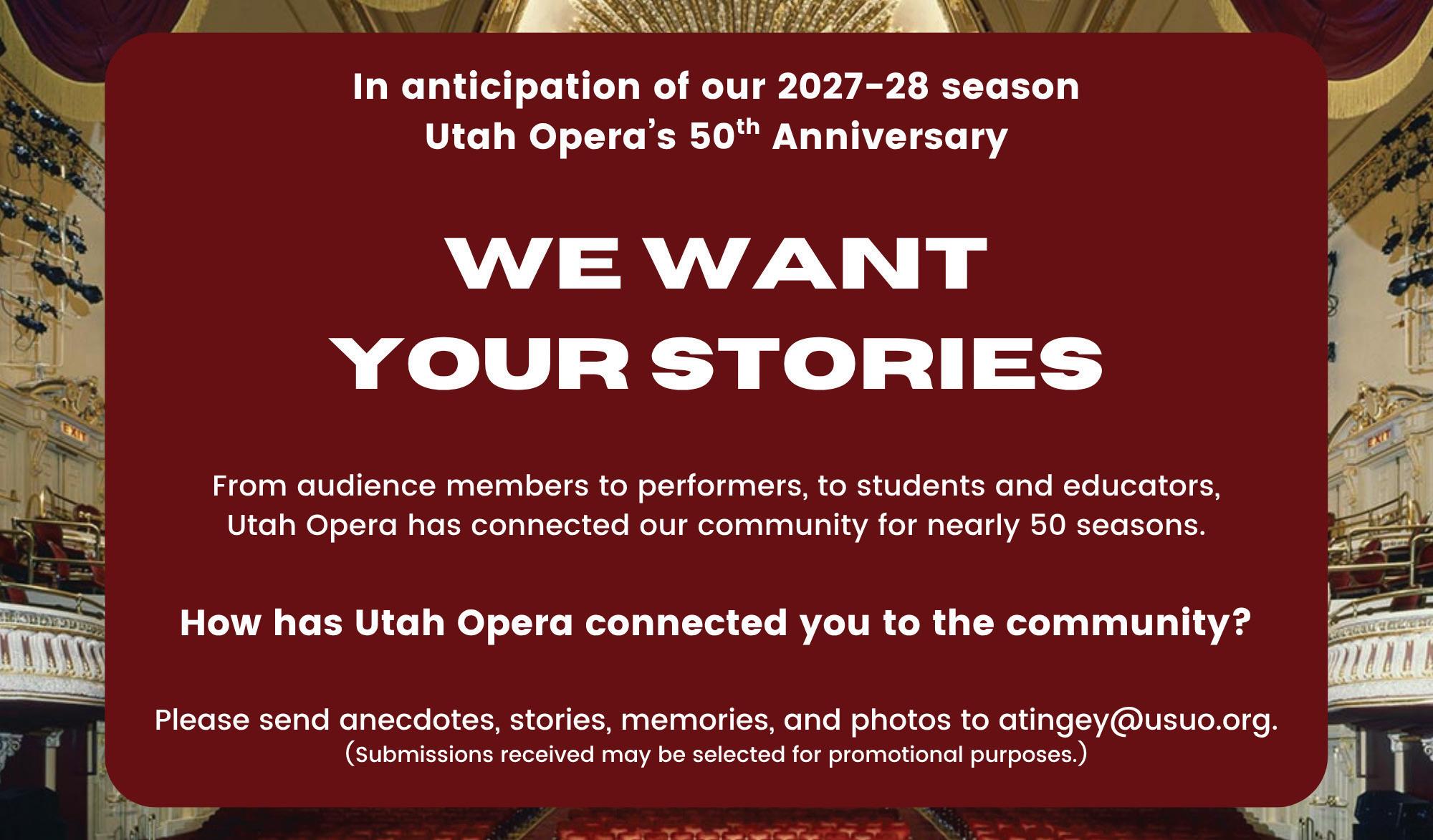

By Tara Faircloth

PERHAPS THE most famous section of the opera Fidelio is the Prisoners’ Chorus, “O welche Lust,” which begins with an ecstatic appreciation of the beauty of a single breath of fresh air. The fact that Beethoven gave the most beautiful music in the entire opera to a chorus of common prisoners shows us, I think, his belief that our connection to a higher power and our longing for freedom is inherent and universal to every man.
Fidelio is Beethoven’s only opera, a work that he re-wrote three times. It has been called a “secular oratorio,” and it is full of the passion that typifies so much of Beethoven’s work. When listening to Beethoven’s music in this piece, it sometimes feels as if the score can barely contain all of the emotion he is trying to express, that it is stretched to its absolute limit, and somehow there is an underlying tension, a sense that if it were possible, he would want you to feel even more than he has been able to capture on the page.
Fidelio has been subject to a multitude of interpretations. In many ways, the opera is a blank slate: the characters are not described in great detail; there is no mention in the score of the exact political situation at hand, and even Florestan’s “crime” against Pizarro is not identified explicitly. Instead, we have a story of brutal revenge versus great love: a broadly appealing theme. The piece features very large-scale ideas that are extremely relevant in the 21st century (the dream of a government free of tyranny, the inherent worth of the individual person), but ultimately it is a story about the incredible bravery of a woman who will stop at nothing to save her husband from a ruthless, unjust death sentence.
Beethoven’s original score includes a great deal of spoken German dialogue, which is a challenge for nonnative singers to learn, and frankly, for an American opera audience to really engage with and enjoy. Our production replaces the German dialogue with narration curated from the words of great revolutionaries, thinkers and poets across the ages. These sections are delivered by The Oracle, a strong, compassionate female presence who guides us through the piece. This character is a guardian of collective memory and a moral compass. She doesn’t intervene directly, but her presence is deeply felt throughout.
There are a lot of “lessons” one might take away from this opera, but instead of teaching lessons, I hope to engage our audience in a very human drama, to make them FEEL something and to connect with the piece, and with each other. I think that experiencing music and drama in this way makes us more empathetic and open to other human beings, and that can only make the world a better place.

“...IN THE MIDST OF DARKNESS, LIGHT PERSISTS.”
- Mahatma Gandhi
By Wendy Bryn Harmer

MY CHILDHOOD memories of Utah revolve around music and theater. The first production I remember seeing at the Janet Quinney Lawson Capitol Theatre was The Nutcracker, followed not long after by Mozart’s Die Zauberflöte (The Magic Flute). Each Christmas, my parents took us to the ballet or to Hale Center Theatre for their production of A Christmas Carol.
My earliest memories of Abravanel Hall are of hearing the Utah Symphony play Beethoven’s Sixth Symphony, watching P.D.Q. Bach zipline onto the stage, playing my flute with Salute to Youth, and singing with the
Salt Lake Children’s Choir. I anxiously awaited turning 10, because my mom would finally let me attend the Messiah Sing-In with the Utah Symphony, something I had long watched my older siblings enjoy. My oldest brother, Dave, shared his score with me as we sat mid-orchestra level and I desperately tried to keep pace with the other amateur vocalists.
Now I love returning to Utah to make music and connect with the incredible people who shaped my path. Returning to perform in Utah means seeing my choir teachers; connecting with Susan Goodfellow (flutist and teacher extraordinaire!), who patiently spent a decade teaching me breath control; and being supported by family and friends who have known me longer than anyone.
I spend a lot of my professional life on stages in other countries or in cities where I don’t have family, so it’s a rare and special gift to know so many people I love are in the audience. Returning to Utah means having an opportunity to perform for those who believed in me long before I believed in myself.
I hope you and your family make lifelong memories at the symphony, the opera, the ballet, and the theater. Enjoy tonight’s performance with someone you love!


BORN IN BONN IN 1770, the eldest son of a singer in the Kapelle of the ArchbishopElector of Cologne and grandson of the Archbishop’s Kapellmeister, Beethoven moved in 1792 to Vienna. There, he had some lessons from Haydn and others, quickly establishing himself as a remarkable keyboard player and original composer. By 1815, increasing deafness had made public performance impossible and accentuated existing eccentricities of character, patiently tolerated by a series of rich patrons and his royal pupil the Archduke Rudolph. Beethoven did much to enlarge the possibilities of music and widen the horizons of later generations of composers. To his contemporaries, he was sometimes a controversial figure, making heavy demands on listeners by both the length and the complexity of his writing, as he explored new fields of music. Although he contemplated others, Beethoven wrote only one opera. This was eventually called Fidelio after the name assumed by the heroine Leonore, who disguises herself as a boy and takes employment at the prison in which her husband has been unjustly incarcerated. The work was first staged in 1805 and mounted again in a revised performance in 1814 under more favourable circumstances. Beethoven completed nine symphonies; a number of overtures (including four for Fidelio); one violin concerto and five piano concertos; as well as a triple concerto for violin, cello, and piano; and a curious “Choral Fantasy” for solo piano, chorus, and orchestra.

JOSEPH FERDINAND SONNLEITHNER was an Austrian librettist, theater director, archivist, and lawyer. He was the son of Christoph Sonnleithner, brother of Ignaz Sonnleithner, and uncle of Franz Grillparzer and Leopold von Sonnleithner. He was a personal friend and attorney of Ludwig van Beethoven, and he wrote numerous librettos, among them the first version of Beethoven’s stage opera Fidelio, Faniska by Luigi Cherubini, and Agnes Sorel by Adalbert Gyrowetz.
A prison, in a different time. Marzelline is the daughter of Rocco, who runs a regional prison. She longs for a better life, full of romance and simple comforts. Jaquino is flirting with Marzelline, with little success; Marzelline refuses his advances because she loves young “Fidelio,” her father Rocco’s new assistant. Fidelio, however, is really a woman named Leonore; she disguised herself in order to search for her husband, Florestan, who was imprisoned two years earlier for his political views. Rocco, impressed by Fidelio’s hard work, gives his blessing to the wedding of Fidelio and Marzelline.
Leonore offers to assist Rocco in the restricted lower cells of the prison. The prison governor, Don Pizarro, must approve such a request, says Rocco, and even if he did there would still be one cell Fidelio could never enter. Marzelline asks if that is the location of the “special prisoner” she’s heard Rocco mention. Upon learning that the prisoner has been there for two years, Leonore realizes it could be her husband.
Don Pizarro arrives with soldiers. He is handed a letter alerting him to an inspection by the Minister of State, Don Fernando. Fernando suspects that Pizarro is holding political prisoners illegally. Distressed by the possibility that Fernando will discover Florestan, Pizarro vents his fear and anger, then orders Rocco to kill Florestan immediately. Rocco—who ordinarily is easily bullied into doing Pizarro’s dirty work for him—draws the line at murder. Pizarro orders Rocco to dig a grave while Pizarro kills the prisoner himself. Leonore, overhearing this exchange, denounces Pizarro and resolves to save her husband by whatever means necessary.
Leonore and Marzelline persuade Rocco to let the prisoners walk in the yard. Blinded by daylight, the
prisoners enjoy a moment of freedom as Leonore looks for Florestan among them.
Rocco asks Leonore to help him in the dungeon. Marzelline and Jaquino rush in with a warning: Pizarro is in a rage about the prisoners’ recess. He enters and confronts Rocco, ordering the prisoners to return to their cells, and Rocco to meet him downstairs.
Florestan, near despair and death, accepts his fate. He imagines Leonore as an angel, leading him to heavenly freedom, then collapses, exhausted.
Rocco and Leonore enter the cell. At first, Leonore does not recognize the prisoner. When she hears his voice, however, she realizes it is her husband, and she begs Rocco to let her offer him some water. Pizarro enters and identifies himself as the man Florestan had sought to overthrow years ago. As Pizarro moves to murder Florestan, Leonore rushes between them, crying out, “First, kill his wife!” They struggle, but are interrupted by a trumpet call signaling the arrival of Don Fernando. Pizarro and Rocco depart to greet him. Overcome with joy and relief, Leonore and Florestan embrace.
Outside, people fill the prison courtyard. The crowd hails Fernando, who releases the prisoners who have been unjustly imprisoned. Rocco presents Leonore and Florestan to Fernando, who is astonished that his old friend is alive. Hearing their story, the crowd calls for Pizarro’s immediate arrest. Fernando gives Leonore a key so she can remove Florestan’s chains, and the crowd celebrates her courage and love.
Synopsis written by Tara Faircloth
Speaking Without Words: The Story Behind Fidelio’s New Costumes
By Julia Lyon

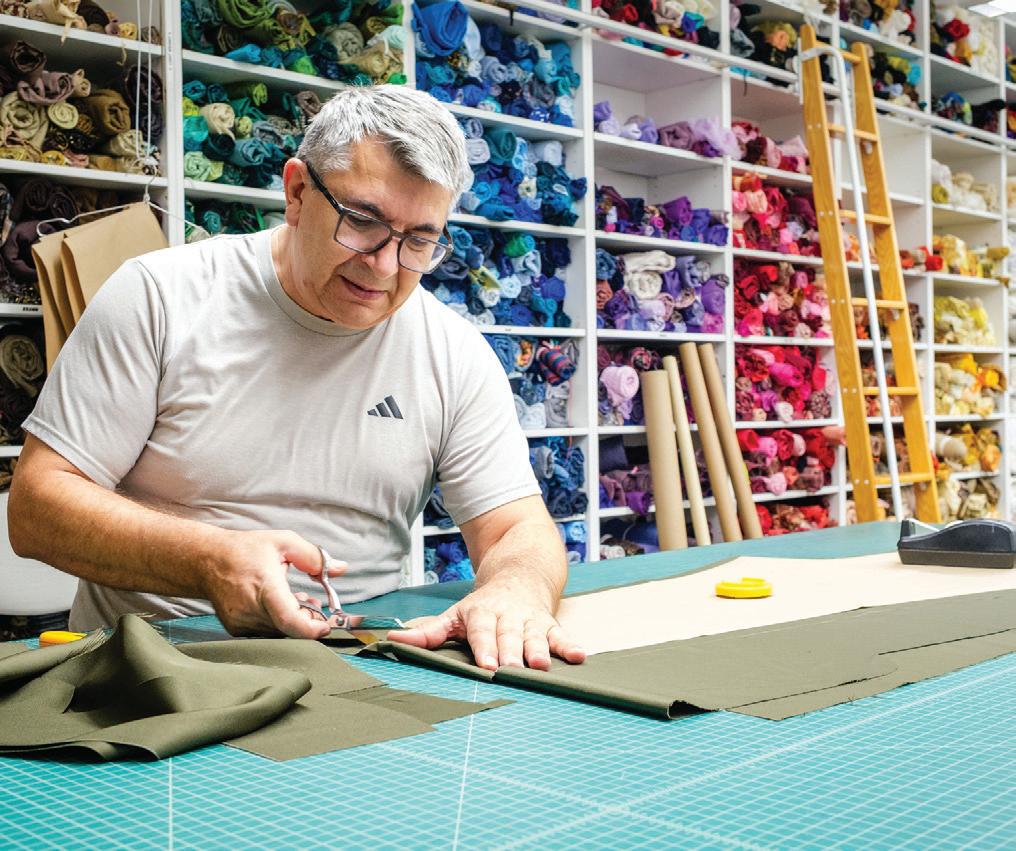
WHEN THE curtain rises this January on Utah Opera’s new production of Beethoven’s Fidelio, the costumes will be unlike anything the audience has seen before. Newly designed by Fan Zhang, an assistant professor of theatre at Weber State University, they reflect the dystopian society where this reimagined Fidelio takes place.
“It’s a world that’s corrupted,” Zhang said. “There’s injustice. There are limited resources and people are struggling.”
Can costumes really say all that? Yes, Zhang says, they can.
For this production, Zhang created designs with shapes and fabrics that send a signal: upcycling is the norm. The audience may not know the exact time or place, but the costumes communicate how hard life is. Fabrics and colors rarely match. Clothes look aged and worn.
How many costumes? 81 different looks totaling more than 600 pieces—from jackets to shoes. The Utah Opera Costume Studio created them all in seven months.
“That’s lightning speed for this size of show,” said Carol Wood, Costume Director.
Using Zhang’s designs, Wood’s team measured singers, sourced fabrics, created patterns, cut, stitched and fit the costumes—while consulting with the designer throughout.
“We refine clear up to opening night,” Wood said.
Growing up in China, Zhang was always fascinated by creating characters through fashion and imagining the universe around them. Now, as she works with students and professionals on theater and opera productions, she still gets to imagine new worlds.
“Each project is really different and needs lots of research,” she said. “It keeps things interesting each time.”
Beethoven’s only opera, Fidelio is often set in World War II, but was originally set in late 18th century Seville, during the period of political unrest following the French Revolution. Zhang welcomed director Tara Faircloth’s vision of a futuristic time and place.
“I want the audience who have seen Fidelio before to feel like this is new and exciting,” Zhang said.


Watch for the shapes of her designs. The asymmetry in many of the silhouettes is a clue something is different. Look for the distinct classes on stage—from authority figures to peasants and prison workers. The movie Dune inspired the military uniforms, Zhang said.
After Zhang drafted her designs, the Costume Studio went to work.
“When we have access to the designer, that’s gold,” Wood said. The team knew they could always reach out to Zhang with questions about colors, fabric, or how the costume should hang on the body.
“Our responsibility is to create the designer’s vision,” Wood said.
Zhang chose most of the fabrics, but the team sourced some items at thrift stores. They cut up old shirts, sweaters and skirts then incorporated them into many characters’ looks, Wood explained.
“The design concept is future dystopian when people must make do with what’s left from a time when people could go shopping for new clothes,” she said.
Each costume almost acts like a language, speaking for the
character before the artist ever sings a note.
On an early September morning, more than four months before opening night, Marcos Ambriz, the Cutter/Draper & Costume Manager, drafted a sleeve for a blouse.
“We start with this beautiful artistic color drawing of her interpretation of the character,” he said of Zhang’s designs. “It’s up to us to take our knowledge and translate her rendering into something real.”
Abby Gehring, the First Hand, explained how she asked Zhang questions as the costumes evolved from design to reality.
“She’s very passionate, even about the small elements,” Gehring said.
Nearby, the industrial sewing machine hummed while Kelsey Nichols, a Stitcher, carefully flat lined, adding a layer of fabric to make the costume more durable.
“It’s so interesting to see something come to life that’s thoroughly unique,” she said.
Over the next few weeks, the costumes would continue to take shape.
Continued on the next page…


“I love seeing something go from flat to a full look especially when the designer’s sketches are really artistic,” said Kathryn Wieland, the Assistant Tailor. “I love to see the details interpreted.”
After the cutting and stitching was done, costumes for Fidelio were “aged,” giving them a lived-in look. Julie Porter, the Crafts Artisan, distressed prison garb with paint brushes and spray paint. She dipped two-thirds of the costume pieces in dye to make them look old, battered, and used.
Porter had shown some examples to the designer, so Zhang could choose how old and beat up she wanted each costume to look.
“Colors behave so differently when they’re under stage lights,” Porter explained.
She’d experimented with different colors to make them look sweaty and old.
“I enjoy using paint to enhance the story,” she said.
Eighty-one costume-looks later, that’s exactly what the Costume Studio had done: enhanced the story with their creations. The best news? Their work will live on once Utah Opera’s run of Fidelio ends in January. The costumes will be available to rent, bringing Fidelio to life on a new stage, hopefully sometime soon.
Utah Opera presents Fidelio January 17–25 at the Janet Quinney Lawson Capitol Theatre.





USUO Presents
MONDAY, JANUARY 26, 2026 / 7:30 PM / ABRAVANEL HALL
JOSEPH THALKEN, conductor
PATTI LUPONE, vocals
SELECTIONS TO BE ANNOUNCED FROM THE STAGE*

CONCERT SPONSOR
RON & KAYE GUNNELL
Team for PATTI LUPONE: MATTERS OF THE HEART
Production Supervisor RICHARD HESTER
Lighting Design JOHN HASTINGS
Sound Design MARK FIORE
Wardrobe Supervisor LYLE JONES
Press & Marketing
CATHERINE MAJOR / C MAJOR ENTERTAINMENT MARKETING
Executive Producer STACI LEVINE / GROUNDSWELL THEATRICALS
PATTI LUPONE is represented worldwide by Opus 3 Artists; MATTHEW OBERSTEIN, Senior Vice President
*Utah Symphony | Utah Opera musicians will not perform at this concert.

JOSEPH THALKEN (Music Direction and Arrangements) is an award-winning composer, conductor, and pianist whose theater and concert works have been performed internationally. His ballet, Chasing Home, was recently released by Albany Records, played by the Dallas Chamber Symphony and available on all streaming platforms. He is the composer of the musicals Was, Harold & Maude, Fall of ’94, Borrowed Dust, and Inventions for Piano. His concert works encompass chamber, choral, orchestral, wind ensemble, and vocal music as well as composing music for the podcast Radio Play Revival. In addition to Patti LuPone, he has served as music director and/or arranger for luminaries of Broadway and classical music, including Julie Andrews, Liza Minnelli, Bernadette Peters, Renée Fleming, Rebecca Luker, Marin Mazzie, Liz Callaway, Sierra Boggess, B. J. Ward, Catherine Malfitano, Elizabeth Futral, Kristin Chenoweth, Sally Wilfert, Polly Bergen, Faith Prince, Hugh Panaro, Michael Crawford, Howard McGillin, Jason Danieley, Nathan Gunn, Rodney Gilfry, Brian Stokes Mitchell, and many more. He has taught music theatre composition at Yale and is a proud graduate of Northwestern University.
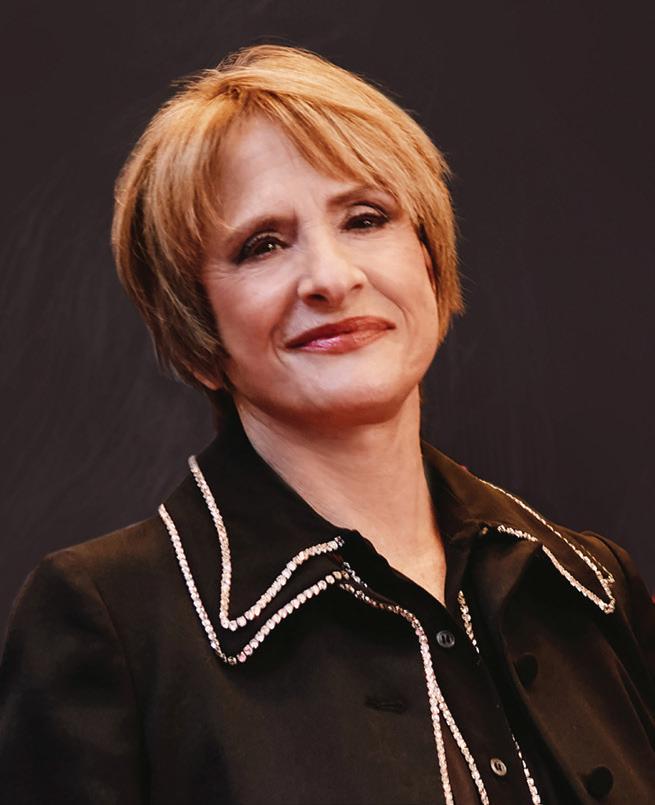
PATTI LUPONE is a three-time Tony Award winner for her performances as Joanne in Marianne Elliott’s gender-swapped award-winning production of the Stephen Sondheim-George Furth musical Company, Madame Rose in the 2008 Broadway revival of the Jule Styne-Stephen Sondheim-Arthur Laurents classic Gypsy and the title role in the original Broadway production of the Andrew Lloyd WebberTim Rice production of Evita. Ms LuPone launched her concert career in 1980 at New York City’s legendary nightclub Les Mouches, performing late-night on Saturdays for 27-weeks, while also performing in Evita. Since then, she has continued to tour extensively, captivating audiences across North America, London’s West End, Australia, and Broadway. Her celebrated concert repertoire includes Don’t Monkey with Broadway, Far Away Places, A Life in Notes, and the upcoming 2026 tour of Matters of the Heart, marking the 25th anniversary of that beloved show. New York stage appearances include: The Roommate; War Paint; Shows for Days; The Anarchist; The Seven Deadly Sins (NY City Ballet); Company (NY Philharmonic); Women on the Verge of a Nervous Breakdown; The Old Neighborhood; Sweeney Todd; Noises Off; Master Class; Anything Goes; Oliver!; Accidental Death of An Anarchist; The Robber Bridegroom. London stage appearances include: Company; Master Class; Sunset Boulevard; Les Misérables; The Cradle Will Rock. Opera: The Ghosts of Versailles (LA Opera); To Hell and Back (SF Philharmonia Baroque Orchestra); The Rise and Fall of the City of Mahagonny (LA Opera-debut); Regina (Kennedy Center). Film: Ari Aster’s Beau is Afraid (opposite Joaquin Phoenix); The School for Good and Evil (Netflix); Last Christmas; The Comedian; Parker; Union Square; Heist; State and Main; Driving Miss Daisy; Witness. TV/Streaming: And Just Like That; Marvel’s Agatha All Along; Hollywood; Pose; Mom; Crazy Ex-Girlfriend; Penny Dreadful; Girls; American Horror Story (NYC and Coven); 30 Rock; Glee; Frasier; and four seasons as Libby Thatcher on ABCs Life Goes On. Ms LuPone is a founding member of both the Drama Division of The Juilliard School and John Houseman’s The Acting Company, and the author of the NY Times best-seller Patti LuPone: A Memoir.




Utah Symphony | Utah Opera is grateful to our generous donors who, through annual cash gifts and multi-year commitments, help us bring great live music to our community.
Millennium ($250,000+)
Anonymous
Marcia JS Richards Jacquelyn Wentz
Encore ($100,000 – $249,999)
Estate of Eva-Maria Adolphi
Estate of Dr. J.R. Baringer
Kem & Carolyn Gardner
Dennis Hranitzky
Scott & Jennifer Huntsman
Anthony & Renee Marlon
John & Marcia Price Family Foundation
Beano Solomon
Norman & Barbara Tanner Charitable Trust
Bravo ($50,000 – $99,999)
Berenice J. Bradshaw Trust
Estate of Dorothy B. Cromer
John & Flora D’Arcy
Dr. Kent DiFiore & Dr. Martha Humphrey
Estate of Barbara Hartman
Estate of Gerry Hixson
Edward Moreton
Frederick & Lucy Moreton
Mark & Dianne Prothro
Dan† & June Ragan
Patricia A. Richards & William K. Nichols
Estate of Joyce Rice
Harris H. & Amanda P. Simmons Foundation
Shiebler Family Foundation
George Speciale
Zibby & Jim Tozer
Wheatley Family Charitable Fund
Overture ($25,000 – $49,999)
Frances Akita & Christine Akita Sulser
Scott & Kathie Amann
Doyle Arnold & Anne Glarner
Thomas Billings & Judge Judith Billings†
Bloomfield Family Foundation
Mr. Charles Boynton
Judy Brady† & Drew W. Browning
Judy & Larry Brownstein
Estate of Stephen L. Fife
Kristen Fletcher & Dan McPhun
Brandon & Kristen Fugal
David & Angela Glenn
Brian & Detgen Greeff
Intuitive Funding
Thomas Jacobson
Charles & Pat McEvoy
Mr. & Mrs. Alvin† Richer
Gifts as of September 24, 2025
in-kind donation
in-kind & cash donations
deceased
Nathan & Shannon Savage
Theodore & Elizabeth Schmidt Foundation
Taft & Anne Symonds
Norman C. & Barbara L. Tanner
Charitable Trust
Naoma Tate & the Family of Hal Tate
John & Jean Yablonski
Maestro ($10,000 – $24,999)
Anonymous
Dr. Jeannette J. Townsend
Beesley Family Foundation
Jim & Susan Blair
Steven & Cassandra Brosvik
Paul Burdiss
Howard & Betty Clark
Joseph & Cathy Cleary
Marian Davis & David Parker
Kathleen Digre & Michael Varner
Estate of Jeff Drenker
Pat & Sherry Duncan
Barry & Traci Eden
Sarah Ehrlich
Pam & Jonathan Eichner
Matthew B. Ellis Foundation
Carolyn & Craig Enenstein
Robert & Elisha Finney
John F. Foley M.D. & Dorene Sambado
M.D. **
Allegro ($5,000 – $9,999)
Anonymous [4]
Austin & Kristi Bankhead
Kyle & Melissa Barnett
Mr. & Mrs. William D. Callister
Marc & Kathryn Cohen
Mr. & Mrs. Kenneth R. Cutler
Fifty50Fifty Family Fund
John H.† & Joan B. Firmage
Sarah Ratchye & Edward Frank
David E. Gee
Diana George
Douglas & Connie Hayes
Susan & Tom Hodgson
Chuck & Kathie Horman
Sunny & Wes Howell
Mary P.† & Jerald H. Jacobs Family
Stephen C.† & Lynda M. Jacobsen
Annette & Joseph Jarvis
G. Frank & Pamela Joklik
G F Larsen Family Charitable Fund
Duncan & Irene Lee
Bill Ligety & Cyndi Sharp
Matthew Prince & Tatiana Lingos-Webb Prince
Michal & Maureen Mekjian
Millburn Philanthropy Trust
The Millerberg Family Giving Fund
Harold W. & Lois Milner
James & Ann Neal
Dr. Dinesh & Kalpana Patel
Leslie Peterson & Kevin Higgins
Frank R. Pignanelli & D’Arcy Dixon
Pignanelli
Walter J. & Peggy Plumb
David & Shari Quinney
Albert J. Roberts IV
Richard & Carmen Rogers
James & Anna Romano
Sandefur Schmidt
Allison Schuster
Jonathan & Marisa Schwartz
August L. Schultz
Dewelynn & J. Ryan† Selberg
Mr. & Mrs. G. B. Stringfellow
Thomas & Marilyn Sutton
Brad E. & Linda P. Walton
Dr. & Mrs. Harry C. Wong
Caroline & Thomas Wright
Kathie Zumbro
Barbara Greenlee
Emma Hamilton & Brian Casper
Neone F. Jones Family
Dr. Donald & Alice Lappe
Tim & Angela Laros
Dennis & Pat Lombardi
Christopher & Julie McBeth
Carol & Anthony W. Middleton, Jr., M.D.
Jed Millburn
Gail Miller & Kim Wilson
Eva Novak
Gifts as of September 24, 2025
in-kind donation
Patricia Legant & Thomas Parks
Glenn Ricart & Patricia Guenther
Kenneth Roach & Cindy Powell
Smith & Wilcox Blue Skies Foundation
Sheryl & James Snarr
Sidney Stern Memorial Trust
Ruth Stone
Steve & Betty Suellentrop
Paul Taylor
Susan Warshaw
Jaelee Watanabe
Abravanel & Peterson Society ($2,500 – $4,999)
Anonymous [4]
Craig & Joanna Adamson
Drs. Crystal & Dustin Armstrong
Scott & Jesselie Anderson
Dr. Peter & Rosemary Beck
Dr. Melissa Bentley
Philip Bienert
Helen & Jeff Cardon
Dr. Thomas D. & Joanne A. Coppin
Michael Brent Davies
Tim & Candace Dee
Matt & Nancy Dorny
Barbara & Melvin Echols
Midge & Tom Farkas
Linda Francis
Mr. & Mrs. Eric Garen**
Bob & Mary Gilchrist
Dr. & Mrs. John Greenlee
Kenneth & Kate Handley
Brad Hare MD & Akiko Okifuji PhD
Jeff & Peggy Hatch
John Edward Henderson
Drs. Carolyn & Joshua Hickman
Dixie S. & Robert P. Huefner
Stephen Tanner Irish
Gordon Irving†
Jay Jackson
Jay & Julie Jacobson
Drs. Randy & Elizabeth Jensen
Maxine & Bruce Johnson
Dr. Michael A. Kalm
Lucinda L. Kindred
Jeffrey LaMora
Nicole & David Langlie
Franklin Lewis
David & Donna Lyon
Heidi & Edward D. Makowski
Hillary Marquardson
Kathryn & Jed Marti
Dale & Carol Matuska
David & Nickie McDowell
George & Nancy Melling
Pieter & Janice Mensink
John & Bria Mertens
Gifts as of September 24, 2025 * in-kind donation
in-kind & cash donations
deceased
Terrell & Leah Nagata
Metta Nelson Driscoll
Elodie Payne
Joel & Diana Peterson
Lisa Poppleton & Jim Stringfellow
Dr. Susan J. Quaal
Mick Rasmussen
Gina Rieke
Kazuhiro Saito
Mark & Loulu Saltzman
Margaret P. Sargent
Gerald† & Sharon Seiner
Gibbs† & Catherine W. Smith
Eddie Stone
Douglas & Susan Terry
Marvin & Sandra Van Dam
Susan & David† Wagstaff
Sally Wakefield & Anthony Arnason
John & Susan Walker
Jennifer Wollin
E. Woolston† & Connie Jo HepworthWoolston
Friend ($1,000 – $2,499)
Anonymous [5]
Alan, Carol, & Annie Agle
Christine A. Allred
Beth & Roger Armstrong
Ian Arnold
Mr. Gaylen Atkinson
Dr. Ann Berghout & Dennis Austin
Fred & Linda Babcock
Lowell Bennion
Vicki & Bill Bennion
Patter & Thomas Birsic
C. Kim & Jane Blair
Roger & Karen Blaylock
Susan Boyer
Céline Carol Browning & Nathan
Sutherland
Mary Bush
Dana Carroll & Jeannine Marlowe
Carroll
Linda Jo Carron
Mr. & Mrs. Fred L. Carter, Jr.
Po & Beatrice Chang
William & Patricia Child
Phillip I. & Gail Coleman
Kenneth Colen
Dr. & Mrs. David Coppin
David & Carol Coulter
Jason & Kristin Covili
Coleen Cronin
Cecilia Crystal
Mark B Dean
Paul Dorgan
Eric & Shellie Eide
David & Susan Erhart
Leonard Farnsworth
The Fickling Family Foundation
Craig Fineshriber & Dr. Nancy Futrell
Drs. Norman L. & Carol† M. Foster
Dr. Robert Fudge & Sylvia Newman
Larry Gerlach
Ralph & Rose† Gochnour
Graf Family Charity Fund
John & Linda Green
Olga Gromadzka
Keith Guernsey & Rebecca Burrage
Dr. Elizabeth Hammond
Helene Harding & Patrick Briggs
Robert & Marcia Harris
Virginia Harris
Jonathan Hart
Lex Hemphill & Nancy Melich
Laura Holleman
Ron & Marsha Houston
Eldon Jenkins & Amy Calara
Jerry & Shari Seiner Family Charitable Fund
Joann & Russell Jex
Dr. & Mrs. Ramon E. Johnson
Bryce & Karen† Johnson
Rebekah & Joseph Johnson
James R. Jones Family
Kimberli Jones
Michael & Amy Kennedy
Hyo J Kim
Alsco Uniforms
Mary Denice & George Koch
Michael & Peg Kramer
Patricia L Leikhim
Ms. Susan Loffler
Neylan McBaine & Elliot Smith
Julie Mckee
Warren K.† & Virginia G. McOmber
Mr. & Mrs. Reed W. Merrell
David B. & Colleen A. Merrill
Jim & Nanette Michie
Dr. Nicole L. Mihalopoulos & Joshua
Scoville
Kenny Mizel
Dr. Louis A. & Deborah Moench
Steven & Sandy Morgan
Barry & Kathy Mower
David Murrell IV & Mary Beckerle
Dan & Janet Myers
Norman & Carol Foster
Maura & Serge Olszanskyj
Stephanie Pappas
Cynthia & George Petrow
Jerry & Nancy Pitstick
Keith & Linda Poelman
Alice & Frank Puleo
Esther Rashkin
Dr. Barbara S. Reid
Frances Reiser
Dale & Susan Richey
Regence BlueCross BlueShield
Gail T. Rushing
Rachel Sabin
Ronald Schwarz
Mr. Jeffrey W. Shields & Ms. Mary Ross
Jeffrey Simmons
Barbara Slaymaker
Jan H. Smith
Stan & Mary Sorensen
Dr. & Mrs. Michael H. Stevens
Clint & Jody Stone
Annie & Cory Strupp
Jay Teevan
Brent & Lissa Thompson
Jean Vaniman
William & Donna† R. Vogel
Frank & Janell Weinstock
Dan & Amy Wilcox
Jody L. Williams
Michael & Judy Wolfe
Tolford & Mary Young Gifts as of September 24, 2025
Utah Symphony | Utah Opera is grateful to those donors who have made commitments to our Endowment Fund.
Anonymous
C. Comstock Clayton Foundation
The Elizabeth Brown Dee Fund for Music in the Schools
Lawrence T. & Janet T. Dee Foundation
Thomas D. Dee III & Dr. Candace Dee Hearst Foundation
Carolyn T. Irish Revocable Trust
The Right Reverend Carolyn Tanner Irish† & Mr. Frederick Quinn
Edward Moreton
The Linda & Don Price Guest Artist Fund
Perkins-Prothro Foundation
Kenneth† & Jerrie Randall
The Evelyn Rosenblatt Young Artist Award
Bill & Joanne Shiebler
Steven P. Sondrop Family Trust
James R. & Susan Swartz
Clark L. Tanner Foundation
Norman C. & Barbara L. Tanner Charitable Trust
Norman C. & Barbara L. Tanner Second Charitable Trust
O.C. Tanner Company
Jack & Mary Lois Wheatley Family Trust
Edward & Marelynn† Zipser
The Endowment Fund is a vital resource that helps the long-term well-being and stability of USUO, and through its annual earnings, supports our Annual Fund. For further information, please contact Garrett Murphy, Director of Development, at (801) 869-9016.
Many donors have made gifts to Utah Symphony | Utah Opera in memory or to honor friends and loved ones. Thank you for your generous tributes.
IN MEMORY OF
Grant Watkins Baker, an original member of the Utah Symphony Orchestra and a Jr High Band teacher
The Millerberg Family Giving Fund
Ruzena (Rose) Novak
Eva Novak
Glade & Mardean Peterson
Leslie Peterson & Kevin Higgins
Kelvin Peterson
Scott & Kathleen Amann
Rick & Betsy Anderson
Kirsten & Gary Dodge
Lory Hendry & Rob Ayres
Joann & Russell Jex
Richard Morais
Shelley Morandi
Sean Myles
Carol Steffen Richards
George & Frances† Alderson
Wallace Ring, MD. Dr. Harry Wong
Bill Shiebler
Tom & Laurie Eastwood
Fickling Family Foundation
Kristen Fletcher & Dan McPhun
Jim & Barbara Gaddis
Veloria M. Jacobson
Allison Kitching
Frank & Alice Puleo
Deanna L Rodeghier
Peggy & Ben Schapiro
Anne & Taft Symonds
The Swartz Foundation
Allison Weiss
David Winder
David & Maun Alston
Anonymous
Janet Topham
Alsco Uniforms
Kerrie D. MacPherson
IN HONOR OF
J. Richard Baringer, MD
Norman L. Foster, MD
Barbara Scowcroft
Dean Zobell
We thank our generous institutional donors for their annual support of Utah Symphony | Utah Opera.
$100,000 or more
AHE/CI Trust
The Church of Jesus Christ of Latter-day Saints Foundation
Emma Eccles Jones Foundation
The Florence J. Gillmor Foundation
Frederick Q. Lawson Foundation
George S. & Dolores Doré Eccles Foundation
Larry H. & Gail Miller Family Foundation
Lawrence T. & Janet T. Dee Foundation
LOVE Communications**
Marie Eccles Caine Foundation-
Russell Family
Marriner S. Eccles Foundation
O.C. Tanner Company
Sorenson Legacy Foundation
Stowell Leadership Group, LLC*
Zions Bank
$50,000 – $99,999
Anonymous
47G Utah Aerospace & Defense**
Crocker Catalyst Foundation
The Grand America Hotel & Little America Hotel*
$25,000 – $49,999
Anonymous
Arnold Machinery
Big-D Construction
BMW of Murray/ BMW of Pleasant Grove
Bill & Vicki Bennion
John & Carol Firmage
John† & Joan Firmage
$10,000 – $24,999
Altabank
B.W. Bastian Foundation
Bertin Family Foundation
R. Harold Burton Foundation
Caffé Molise*
The Capital Group
Enbridge Gas
Goldman Sachs Philanthropy
Janet Q. Lawson Foundation
Marriott Residence Inn*
Minky Couture*
Moreton & Company
S.J. & Jessie E. Quinney Foundation
Salt Lake Chamber*
World Trade Center Utah*
Cultural Vision Fund
Deer Valley Resort*
Goldman Sachs & Co. LLC
Richard K. & Shirley S. Hemingway Foundation
The Kahlert Foundation
The John C. Kish Foundation
McCarthey Family Foundation
Moreton Family Foundation
Charles Maxfield & Gloria F. Parrish Foundation
Simmons Family Foundation
Summit Sotheby’s International Realty
Nora Eccles Treadwell Foundation
Joseph & Kathleen Sorenson Legacy Foundation
Merit Medical Systems, Inc.
Park City Chamber of Commerce & Visitors Bureau
Pura
Regence BlueCross BlueShield of Utah
The Joseph & Evelyn Rosenblatt Charitable Fund
Gifts as of September 24, 2025 * in-kind donation ** in-kind & cash donations
deceased
Joanne L. Shrontz Family Foundation
Stewart Education Foundation
Swartz Foundation
University of Utah Health
Utah Valley Chamber of Commerce
WCF Insurance
Woodbury Corporation
$1,000 – $9,999
Anonymous Amano Artisan Chocolate*
Bank of America
The Buckner Company
Chartway Credit Union
CHG Healthcare Services
Dominion Energy Arts Foundation
Spencer F. & Cleone P. Eccles Family Foundation
Henry W. & Leslie M. Eskuche
Charitable Foundation
Every Blooming Thing*
The Fanwood Foundation Western Office
Holland & Hart
Huntsman International LLC
Intermountain Health
J. Wong’s Thai & Chinese Bistro*
Kennecott Utah Copper LLC
Key Bank
KKC Foundation
Microsoft Corporation*
Millcreek Coffee Roasters*
Mountain America Credit Union
Mountain Temp Services, LLC
Osher Lifelong Learning Institute
Precision Hermetic Technology
Ray, Quinney & Nebeker Foundation
Red Rock Brewing Company*
Ruth’s Chris Steak House*
Salsa Queen SALTT
Serving Table 22*
Spencer Fane Snow Christensen & Martineau Foundation
Squatters Pub Brewery*
Stay Park City
Summerhays Music Center
Swire Coca-Cola, USA*
Trujillo Acosta Law
Urban Hill
Utah Autism Foundation
Vergara Miller Law
Vox Marketing Group*
Wells Fargo
Utah Symphony | Utah Opera would like to especially thank our major sources of public funding that help us to fulfill our mission and serve our community.
Salt Lake County Zoo, Arts & Parks
Utah State Board of Education
Utah Department of Cultural & Community Engagement
Utah Division of Arts & Museums
Utah Office of Tourism
Utah State Legislature
Summit County RAP Tax



Summit County Restaurant Tax
National Endowment for the Arts
Salt Lake City Arts Council
Orem City CARE Tax


Utah Symphony | Utah Opera offers sincere thanks to our patrons who have included USUO in their financial & estate planning.
Beethoven Circle (gifts valued at more than $100,000)
Anonymous [3]
Doyle Arnold & Anne Glarner
Edward R. Ashwood & Candice A. Johnson
Dr. J.R. Baringer†
Dr. Melissa J. Bentley
Marcy & Mark Casp
Shelly Coburn
Raymond & Diana Compton
John & Flora D’Arcy
Anne C. Ewers
Annette W. & Joseph Q. Jarvis
Flemming & Lana Jensen
James Read Lether
Daniel & Noemi P. Mattis
Anthony & Carol W. Middleton, Jr., M.D.
Robert & Diane Miner
Glenn Prestwich
Kenneth A.† & Jeraldine S. Randall
Marcia JS Richards
Mahler Circle
Anonymous [3]
Dr. Robert H.† & Marianne Harding Burgoyne
Richard Clegg
Mr. & Mrs. Kenneth E. Coombs
Robert & Carolee Harmon
Barbara Hartman†
Richard G. & Shauna† Horne
Virginia A. Hughes
Herbert C.† & Wilma Livsey
Dianne May
Jerry & Marcia McClain
Anonymous
Judy Brady† & Drew W. Browning
Dr. Robert H.† & Marianne Harding
Burgoyne
Richard Clegg
Shelly Coburn
Travis & Jamie Donio
Anne C. Ewers
Joseph & Pat Gartman
Annette W. & Joseph Q. Jarvis
Edward R. Ashwood & Candice A. Johnson
Herbert C.† & Wilma Livsey
Richard W. & Frances P. Muir
Marilyn H. Neilson
Carol & Ted Newlin
For more information, call (801) 869-9001
† Deceased
Louis & Deborah Moench
Jim & Andrea Naccarato
Stephen H. & Mary Nichols
Craig S. Ogan
Mr. & Mrs.† Scott Parker
Mr. & Mrs.† Michael A. Pazzi
Patricia A. Richards &
William K. Nichols
Mr.† & Mrs. Alvin Richer
Laura Scholl
Jeffrey W. Shields
G.B.† & B.F. Stringfellow
Dr. Ralph† & Judith Vander Heide
Edward J. & Marelynn† Zipser
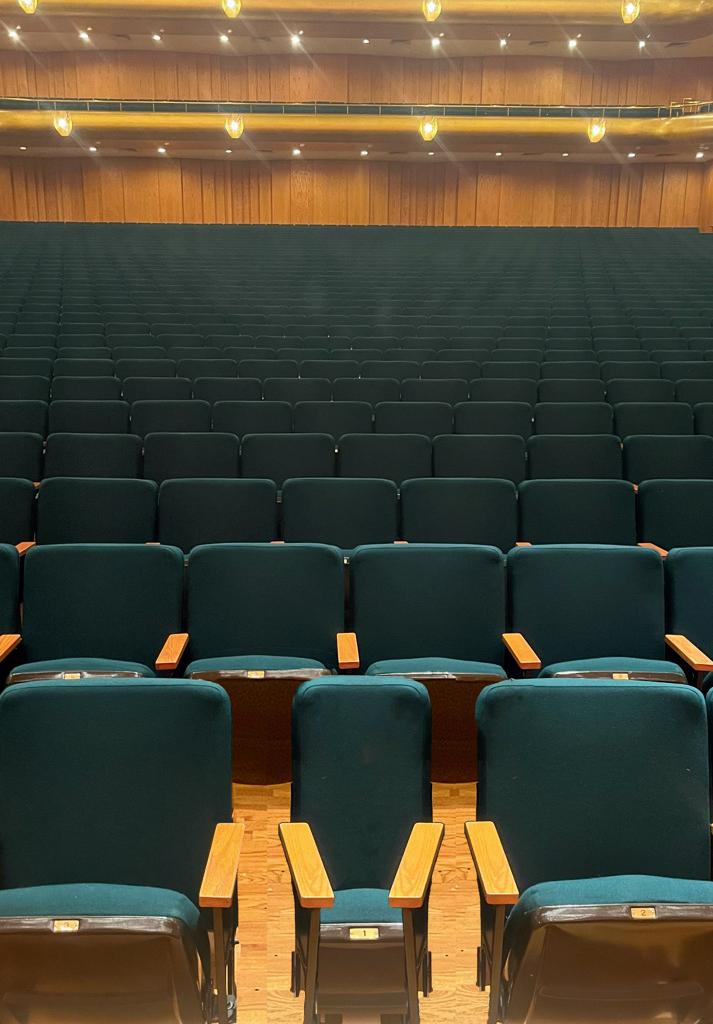

The remaining 2/3 comes from generous supporters like you. With ticket sales covering roughly 30% of the cost of our performances, your contribution helps complete the experience. Here’s
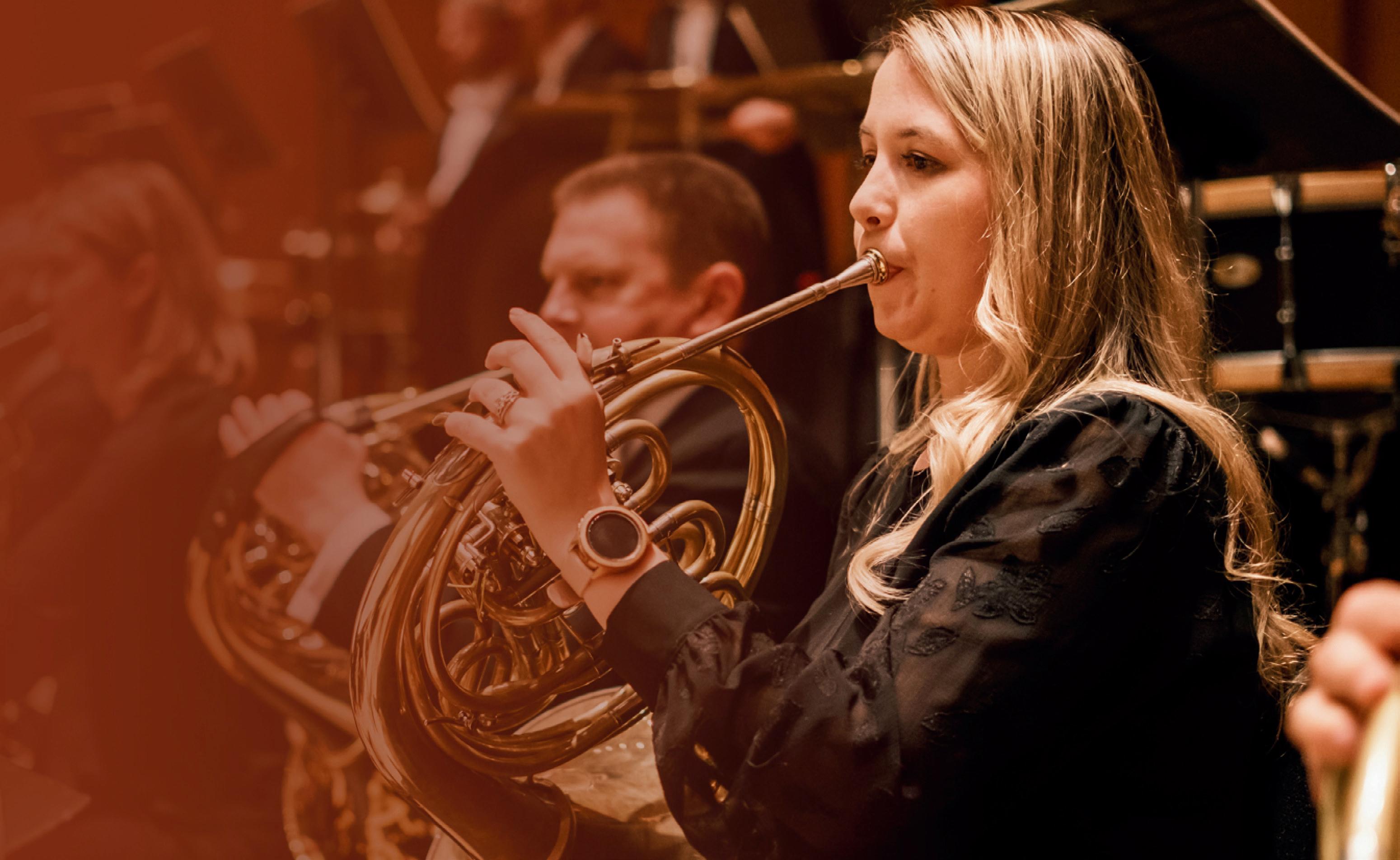
“When I was young, I dreamed about becoming a professional horn player. I attended Eastman School of Music, but realized there was little chance of a female brass player being hired by a major orchestra. Today, I can be part of the Utah Symphony horn section through financial support, adding my name to the principal horn chair. My childhood dream is now realized in a different way.”
-Marci Richards
Foster a unique connection with the individual behind the music while supporting the Symphony’s commitment to excellence.
LEARN MORE
by contacting
Development of Director Murphy, Garrett gmurphy@usuo.org
Make a lasting impact while meeting your financial goals today. Including Utah Symphony | Utah Opera in your will is simple, often taxadvantageous, and helps ensure the power of music touches lives for generations to come. To learn more, please reach out to your financial advisor or contact us at: 801-869-9200 usuo.org/planned-giving



UTAH SYMPHONY | UTAH OPERA 123 W. South Temple Salt Lake City, UT 84101
801-533-5626
EDITOR
Julia Lyon
HUDSON PRINTING COMPANY www.hudsonprinting.com 241 West 1700 South Salt Lake City, UT 84115 801-486-4611
AUDITING AND ACCOUNTING SERVICES PROVIDED BY Tanner, llc
LEGAL REPRESENTATION PROVIDED BY Greenberg Traurig, llp Parsons Behle & Latimer, llp
ADVERTISING MEDIA & WEBSITE SERVICES PROVIDED BY Love Communications, Salt Lake City

The organization is committed to equal opportunity in employment practices and actions, i.e. recruitment, employment, compensation, training, development, transfer, reassignment, corrective action and promotion, without regard to one or more of the following protected class: race, color, religion, sex, national origin, age, disability, family status, veteran status, sexual orientation, gender identity and political affiliation or belief.
Maurice Abravanel Hall and and The Janet Quinney Lawson Capitol Theatre are owned and operated by the Salt Lake County Center for the Arts.
By participating in or attending any activity in connection with Utah Symphony | Utah Opera, whether on or off the performance premises, you consent to the use of any print or digital photographs, pictures, film, or videotape taken of you for publicity, promotion, television, websites, or any other use, and expressly waive any right of privacy, compensation, copyright, or ownership right connected to same.


